Every other Tuesday, you’ll get actionable tips to land your dream job. Subscribe

Best Resume Format to Use in 2023 (Tips and Examples)
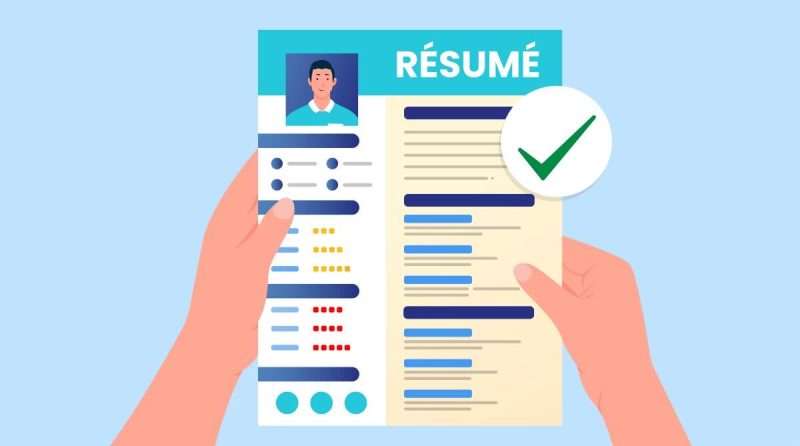
So you want to write a resume for yourself, but you’re not sure how to format it. What is the most popular resume format in 2023? Which resume format do recruiters like to see? You feel like making one wrong step can cost you that interview.
Maybe you came here to double-check which of the three standard resume formats you should pick. Maybe you want to learn about the basics of resume styling, layout, and typography. Either way, we’ve got you covered.
In this article, you’ll learn:
- How to pick the best resume format (reverse chronological, functional, combination)
- How to format a resume in terms of design and layout: which fonts to pair, what font size to use, how to set margins, and so on
- How to format a resume in terms of the structure: which sections to include, the order of sections, and how much information to provide
- Which file format to use when saving a resume (PDF, DOC, DOCX, etc.)
You’ll end up with an eye-catching, professionally formatted resume that will make you look good in the eyes of recruiters and hiring managers.
The Three Main Resume Formats
There are three standard resume formats, each highlighting a different set of your biggest achievements.
You can choose between them based on several factors: the type of job you’re applying for, the industry, and your work experience. The three resume formats are:
Reverse chronological resume format
- Functional (or skills-based) resume format
Combination resume format
Let’s take a look at some resume examples.
Reverse chronological resume sample
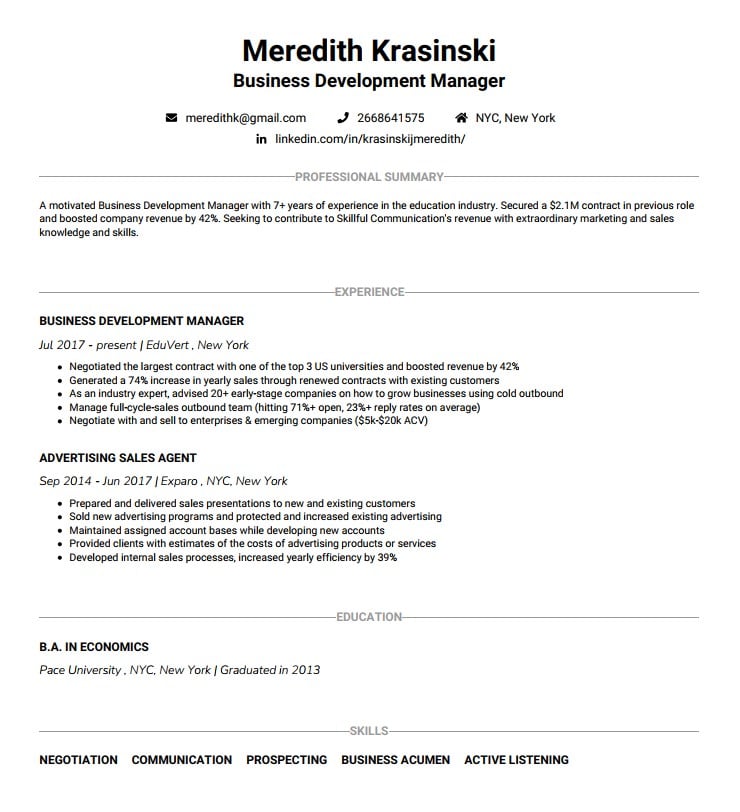
Functional resume sample
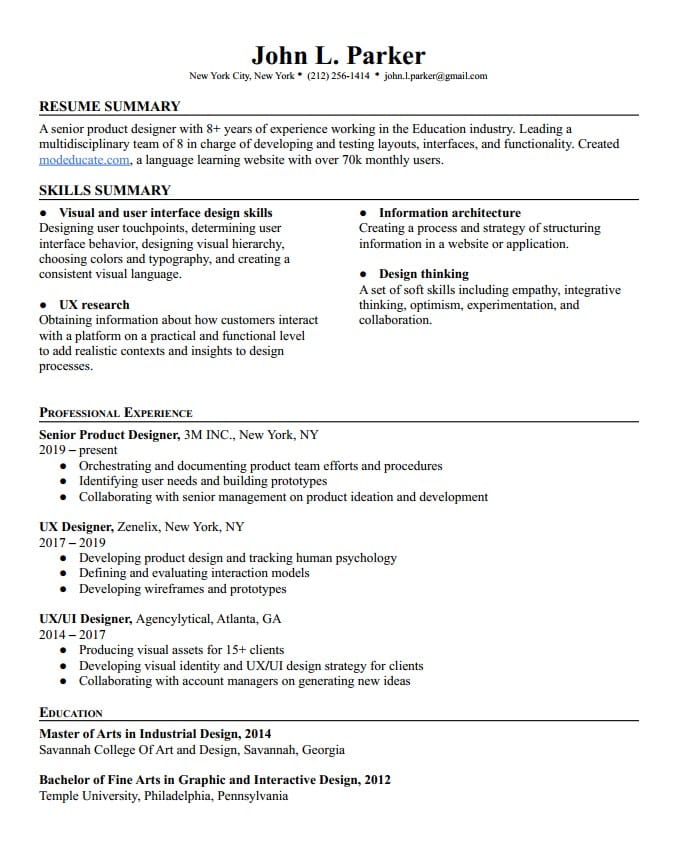
Combination (hybrid) resume sample
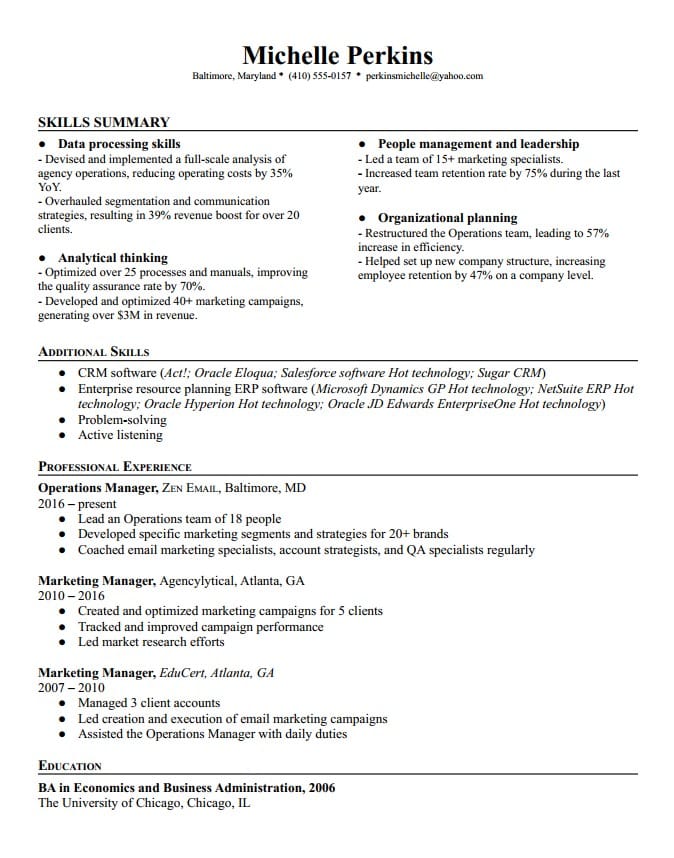
You’ve seen pitch-perfect examples of resumes written in each of the standard formats. Now, see which one suits your current career situation best.
The key area of focus in this resume format is your work history section. You list your work experience in reverse chronological order, beginning with your current or most recent position, followed by the one before it, then another one, and so on.
This format is the safest (and usually the best) pick for virtually any candidate. You’ll find out why in a moment.
Here’s an example of the reverse chronological resume format:
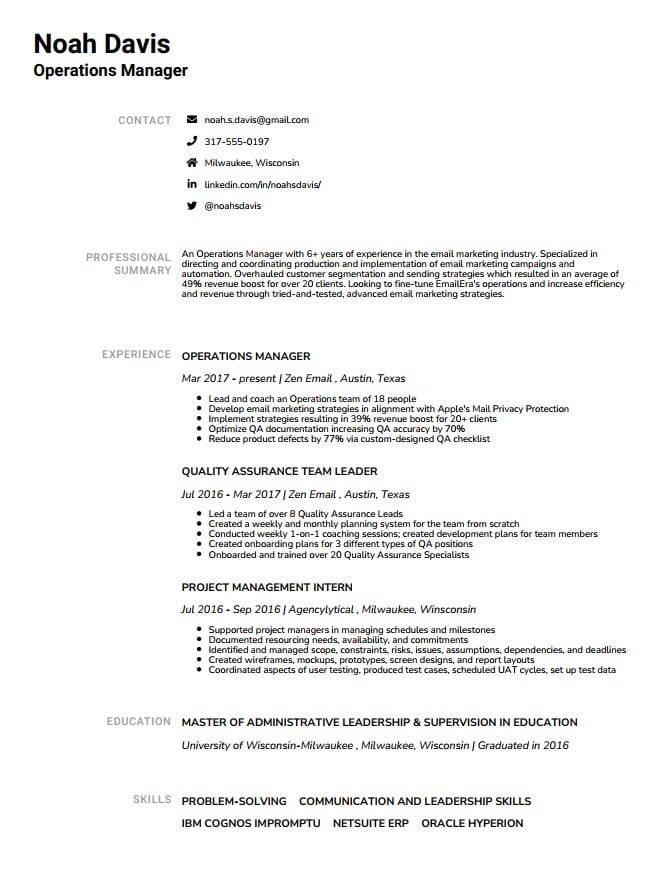
Why the reverse chronological resume format is the best
This is, by far, the most common resume format. In addition, in 95% of cases, it’ll be the best format for you. This is because:
1. Recruiters are familiar with it.
And they really like it! The reverse chronological resume highlights what matters the most for recruiters. It makes their job easier because it takes them less time to spot your key skills and accomplishments. Plus, from a purely psychological point of view, humans love familiarity because it means comfort. Therefore, using a familiar resume format might increase your chances with recruiters.
2. It highlights your best achievements.
Your work experience and achievements are often key things that recruiters search for in a resume. This resume format makes them readily available in the top third of your resume, showcasing just how successful you are.
3. It’s ATS-friendly.
A lot of companies use Applicant Tracking Systems (ATS) — a software that scans your resume and looks for key information before any human lays eyes on it. Consider it a pre-step in recruiting. If you don’t pass it, a recruiter will never get the chance to check out your resume and you’ll never land an interview. That’s why it’s best practice to use a reverse chronological resume, as ATS is “used to it” and it’ll increase your chances of getting noticed.
Sections to include in a reverse chronological resume
Here’s what you need to include in your reverse chronological resume format, in this exact order:
1. Contact information
Here’s where your name goes, along with your email address, phone number, location, LinkedIn URL, and optionally other information such as a blog, portfolio, or relevant social media. You can also include your job title below your name, but it’s optional.
Don’t add your photo and date of birth (in most countries it’s frowned upon, in the US it’s plain illegal).
Additionally, use a professional email address containing only your name and surname, and make sure there are no typos in your email address and phone number.
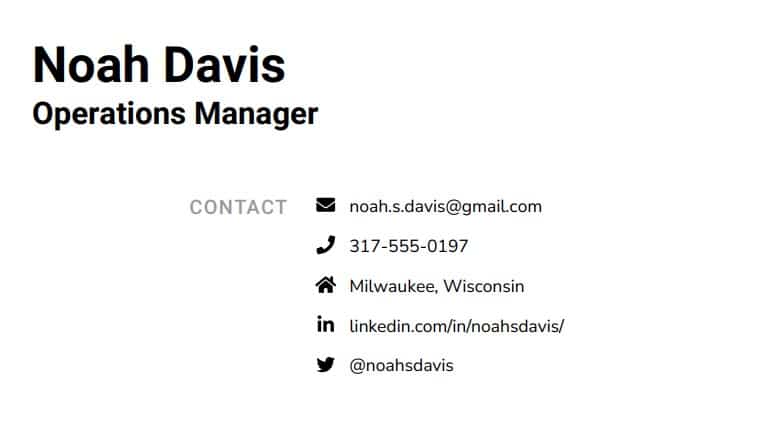
2. Resume summary or resume objective
Summarize the most important information about yourself in 2–4 sentences. Include your role and years of experience, key accomplishments and skills, and what you can bring to the table. If you don’t have a lot of experience, focus on your transferable skills, education, certifications, and the desired goal (again, with a focus on what you bring to the table). If you’re a student, learn how to acquire skills for your resume .

3. Work experience
Without a doubt, this is the key section.
Here, try to focus on achievements rather than duties. List your positions in reverse chronological order and format it like this:
- Company name and location
- Employment dates
- Main responsibilities (list them in bullet points and make sure you list key achievements, both qualitative and quantitative)
- For your current or most recent position, include up to 7 bullet points
- As you go back in time, limit the number of bullets per entry
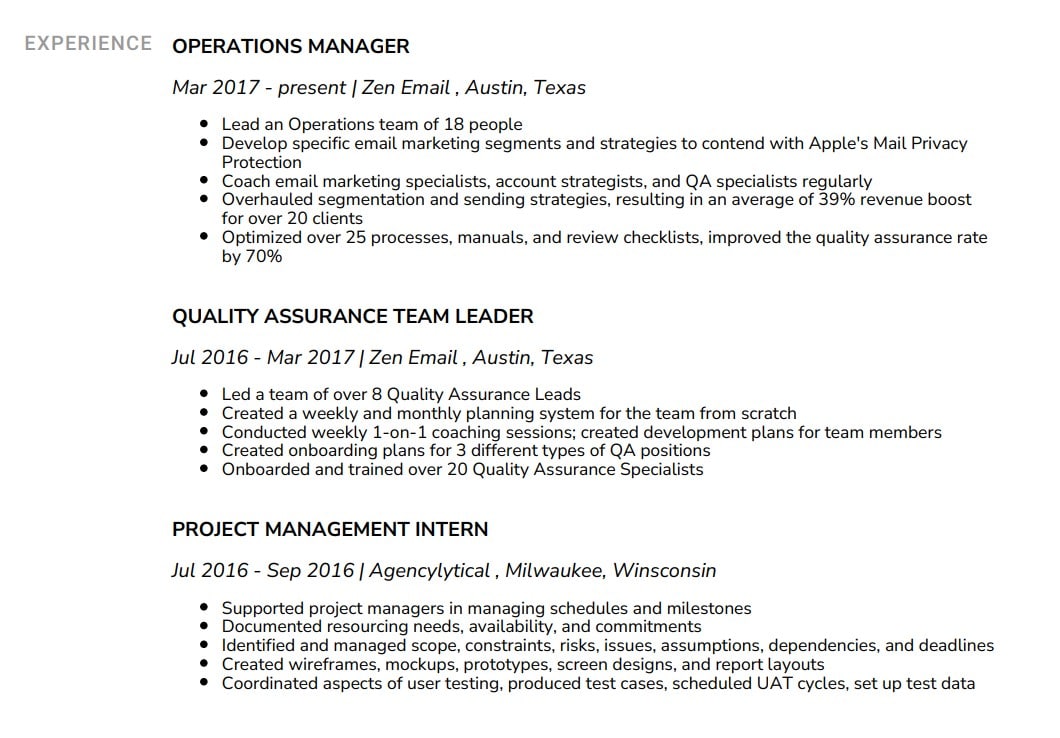
For more details and a ton of examples, see our article: Work Experience on a Resume .
4. Education
Start with your highest degree. If you have a bachelor’s degree, there’s no need to list high school. If you have an MA or an MSc, list it alongside your bachelor’s.
If you have little experience, feel free to place the education section at the top, before the work history section. Here is how to format this section:
- Include your degree, field of study, and major
- University name and location
- Years attended
- GPA (only if 3.5 or higher)
- Awards and honors (if any)

For a super-detailed guide on how to list education on a resume (and a ton of examples and templates to copy), check out this article: Education Section on a Resume: How to Structure It for Greatest Impact .
Don’t disregard this section just because you think that work experience and education are more important. Listing your hard and soft skills on a resume can make you stand out, as they are a testament to why you’d be a great fit for a certain position.
Figure out what skills are needed for the position you are applying for and then include them in case you have them. You’ll want to list them in bullet points, as single items.
Obviously, don’t list skills you know you don’t have. Recruiters are trained to spot resume liars. They will find out.
For more info on why resume skills matter and what the best hard and soft skill combos are, check out Which Skills to Put on a Resume , no matter your job and industry.
6. Additional sections (optional)
This is a place for you to list all the things that can prove your worth and set you apart from the competition. Think awards, certificates, conferences, projects, publications, volunteer work (especially if you’re a recent grad!), languages, and hobbies. Spice it up!
Listing these is great because they show your personality and values, how you spend your free time , if you’re a lifelong learner, what skills you develop through your hobbies, and much more.
For more details on what to include in these sections, take a look at our How to Write a Resume article — it’s full of useful tips and examples.
Reverse chronological resume format: pros and cons
- ATS-friendly
- Recruiters are familiar with it
- It highlights the biggest successes in your career so far
- It’s easy to skim and pick up the key points quickly
- Employment gaps are noticeable immediately
- Not ideal for career changers
- If you don’t have a lot of experience, it might be hard to fill out
- It’s very common so it might be harder to stand out
Functional resume format
This type of resume format focuses on your skills rather than your experience. If you’re applying for a highly creative position and your portfolio is more important than your resume, you could pull the functional resume format off.
In all other cases, this is usually the worst option you can choose, as it’s not particularly liked by recruiters, it’s not ATS-friendly, it can conceal the most important information about you and your experience, and it might make you look like you’re trying to hide something.
However, we don’t do discrimination here at Big Interview, and that’s why we’re going to lay out all the functional resume format details for you. 😉
Here’s a functional resume example.
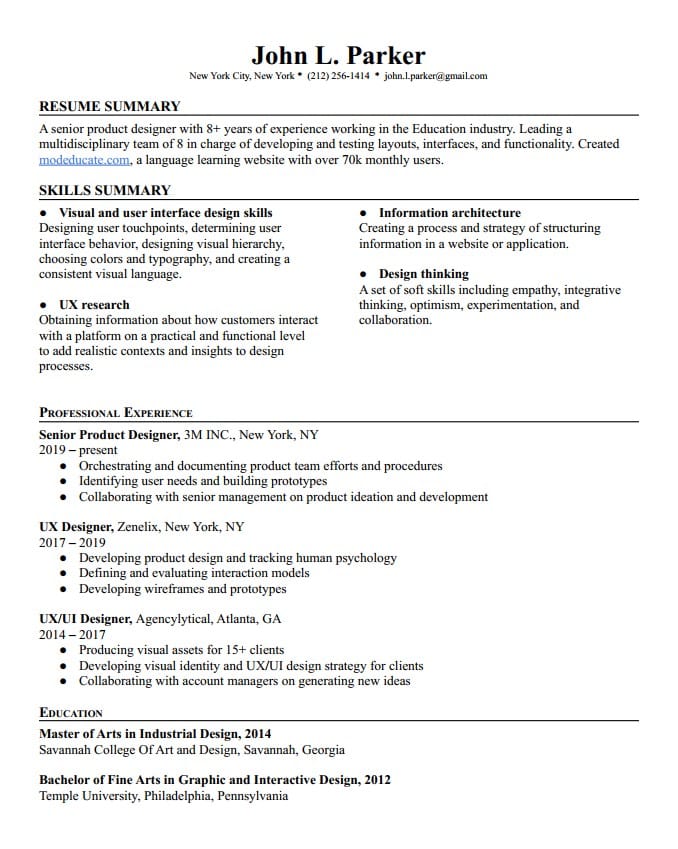
Sections to include using the functional resume format
The main principles remain the same as for the reverse chronological resume format, but there are slight twists.
Here’s what to include in a functional resume format:
Include the basics here: first and last name, phone number, location, email address, LinkedIn URL. You can also add (although it’s optional) the following: portfolio, blog, social media with content relevant to the position… (Remember that you shouldn’t add your headshot and date of birth.)
2. Resume summary or resume objective
In 2–4 sentences, include your role and years of experience, key accomplishments and skills, and how you can contribute to the company you’re applying to. In case you’re inexperienced, focus on your education, desired goal (how you can contribute), certifications, or (transferable) skills.
3. Skills summary
This is the most important section in the functional resume format! Think of this as the main things you’re bringing to the table, the key skills that are guaranteed to make you successful in the position and “sell you” to the recruiter.
Make sure to carefully pick out key hard and soft skills relevant to the position.

Above, you can see a bad example of the skills summary section in the functional resume format for the position of Product Designer. The candidate listed the skills without elaborating on each; in addition, the skills listed here are not specific enough and don’t provide the full picture of this person’s abilities.
Below, you’ll see a good example of the same section for the same position. The candidate picked out key hard and soft skills, elaborating on each. This way, a recruiter will be able to see that the candidate is experienced and suitable for the position.
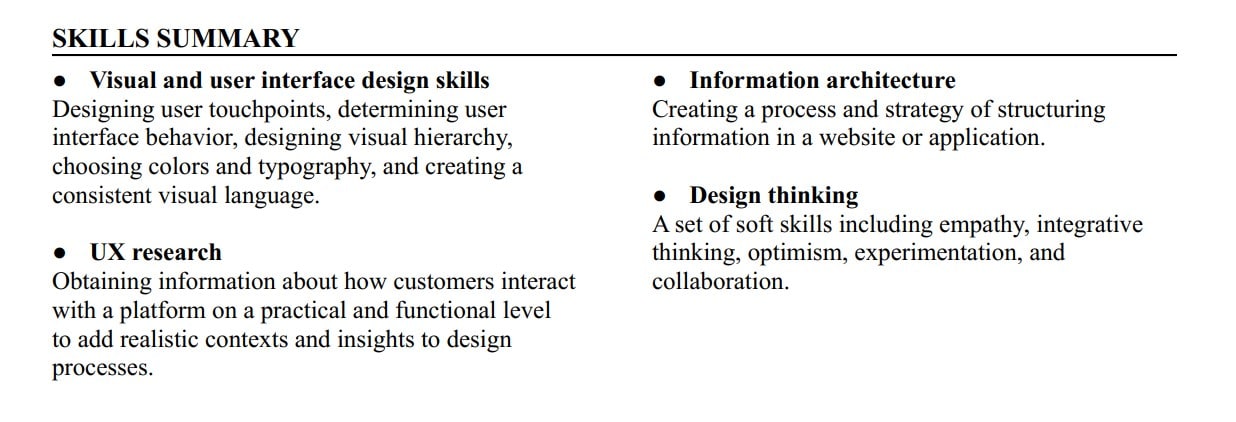
4. Work experience
List your positions in reverse chronological order and format them in this order:
- Job title, company name, and location
- Main responsibilities (in bullet points; list crucial achievements, both qualitative and quantitative). If you don’t have relevant work experience, include volunteer work here, as well as internships.
5. Education
List your highest degree first. Then, go back in reverse chronological order. If you have a BA or a BSc, don’t list high school. If you have an MA or an MSc, list both your master’s and bachelor’s.
Here is how to format this section. Include your:
- Degree, field of study, and major
Functional resume format: pros and cons
- Good for highly creative candidates and positions, as well as freelancers
- Good for highlighting transferable skills
- Difficult to quickly scan
- Disliked by recruiters
As the name suggests, the combination resume format is a combination of reverse chronological and functional resume formats.
In theory, it’s awesome and tempting, because it highlights your experience and skills and validates them immediately.
But in practice, it’s really hard to pull off because it’s suitable only for highly experienced candidates.
Still, if you have a lot of experience and you’re fairly sure the company you’re applying to is not using an old-school ATS (this resume format is somewhat ATS-friendly but older types of software might not parse it properly), it might be a decent choice.
Take a look at the combination resume example below.

Sections to include with a combination resume format
This resume format includes 2 different skill-related sections. Here’s what to include and in which order:
Your name, email address, phone number, location, LinkedIn URL, and optionally other information such as a blog, portfolio, relevant social media, and similar. (Don’t add your photo and date of birth!)
2. Skills summary
Again, this is the key section using the combination resume format. List the crucial skills that have shaped you into the professional that you are today and that will help you nail your new job on a day-to-day basis. Don’t forget to include quantitative/qualitative proof of the great work you did with those skills, don’t just theorize about them without evidence to support it.
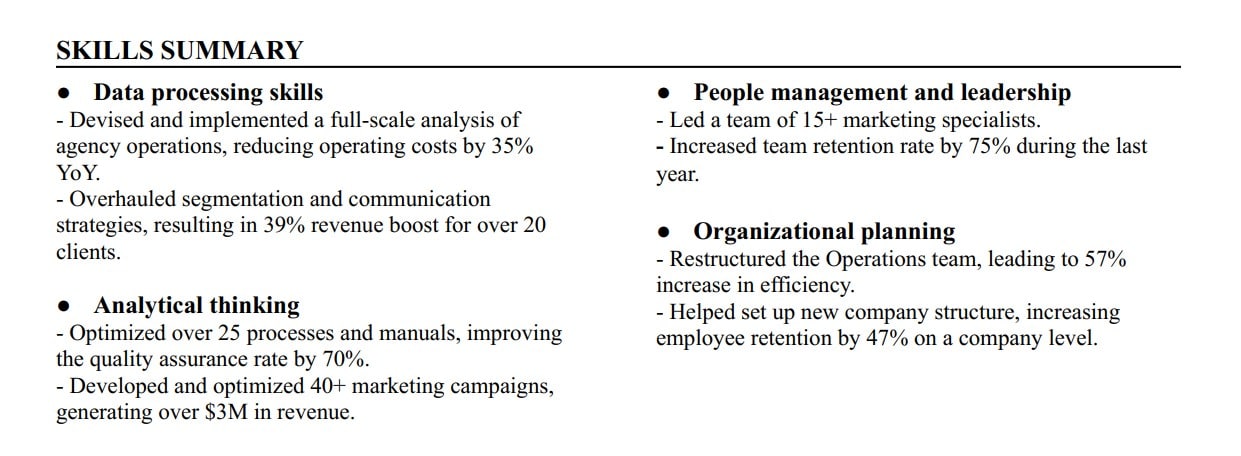
3. Additional skill sets
Here, you’re adding complementary skills. These can be additional, but less relevant hard skills important for the position, or complementary soft skills that will seal the deal and make you the perfect candidate.
You don’t need to be as detailed here as in the Skills summary section.

Keep it short and sweet, list your positions in reverse chronological order and format it like this:
- Main responsibilities (in bullet points and make sure you list key achievements, both qualitative and quantitative). If you don’t have relevant work experience, don’t opt for this resume format.
Same as with any other resume format. The highest degree of education you’ve completed at the top, followed by previous ones. If you have a bachelor’s, skip high school.
When formatting this section, include:
- Your degree, field of study, and major
Combination resume format: pros and cons
- Focuses on both experience and skills
- Good for highly experienced candidates
- Not convenient for the majority of candidates
- Difficult to write
How to choose the best resume format for you
Wondering which resume format might be the best for you? It’s simple.
Use the reverse chronological resume format if you’re:
- An experienced candidate with linear career progression and without employment gaps
- Mid-level professional
- Entry-level job seeker (in this case, rearrange Work Experience and Education sections)
Use the functional resume format if you’re:
- A creative worker (copywriter, designer, musician) or in any role where a portfolio matters more than a resume
- An ex-military professional transitioning to a civilian job
However, use the functional resume format at your own risk.
Finally, use the combination resume format if you’re:
- A highly experienced professional or a specialized candidate
- A career changer (with many years of experience nonetheless)
And now… let’s break down the remaining ambiguities of the phrase “resume format!”
The Basics of Resume Formatting
The resume layout, that is, your resume’s formatting, affects its appearance the most. You need to format your resume so that it’s easily scannable, clean, organized, and clutter-free. Here’s how.
For an elegant look that’s neither too empty nor too cluttered, set the margins to one inch on all sides . In case you need some extra space, there’s an option to reduce them slightly, but don’t go below ½ of an inch, otherwise your resume will look stuffy.
Fonts and font sizes
You’ll want modern and easily readable fonts such as Arial, Helvetica, Tahoma, Times New Roman, Verdana, Calibri, or Roboto . Avoid Comic Sans, Courier New, and Lucinda Console.
Pair two different fonts (one for normal text, one for headers) to stand out: for example, one Serif font and one Sans Serif font to make your resume interesting and balanced.
Use bold and italics to highlight certain parts of your resume; you can bold the headings and italicize subheadings or previous job titles and dates in a company.
As for the font size, use 11–12pt for normal text and 14–16pt for headers and section titles.
Whatever option you choose, make sure to use it consistently throughout your resume.
Line spacing
Things are fairly simple here: use a single-spaced format up to 1.5-point spacing.
Header with contact information
This is the very first section at the top of your resume.
It contains your name, email address (make sure it’s a professional one, not the one you’ve been using since high school!), phone number, location, LinkedIn URL, and other relevant information such as a blog, portfolio, relevant social media, and similar.
What’s important to remember here is that, if you’re applying for a job at an American company, you should not add your date of birth and your photo to the header with contact information. There’s really no need for recruiters and hiring managers to know what you look like, as your experience and achievements will speak for themselves. The same goes for the UK and Ireland.
However, in South America, Asia, Africa, and the Middle East, adding a photo is desirable. In Western Europe, resume photos are acceptable but gradually going out of fashion.
Visually highlighted headers
The headers are the main pointers towards key things in your resume. You need to use them carefully to direct recruiters to the stuff you want to highlight.
Make them stand out by using a different font (one font for all the headings, one font for normal text) and font size ( 14–16pt ).
Many resume builders will let you choose between several different looks which style headers in various ways, so you can pick the one you like best.
The proper order of sections
A rule of thumb is to use the reverse chronological order format, which calls for this order of sections:
- Contact information
- Resume summary or resume objective
- Work experience
- Additional sections (optional): certifications, volunteer work, publications, etc.
If you don’t have relevant work experience, or you’re still a student or a recent graduate, you can put education information before work experience:
If you opt for a functional resume format , this is your order of sections:
- Skills summary
Finally, if you chose a combination resume format , it goes like this:
- Additional skills set
Bullet points
Use bullet points to list work experience and education. Don’t go above 7 bullet points per entry. Remember to focus on key achievements rather than day-to-day duties when listing work experience in bullet points.
How to format dates
When listing work experience, you can list only years when you were employed at a certain company. Alternatively, you can use months and years, but there’s no need to add days too.
When listing education, you can list years attended or only graduation year. If you wish to, you can add a month.

You can also add dates when you obtained certain certificates, completed projects, gave a lecture, and similar.
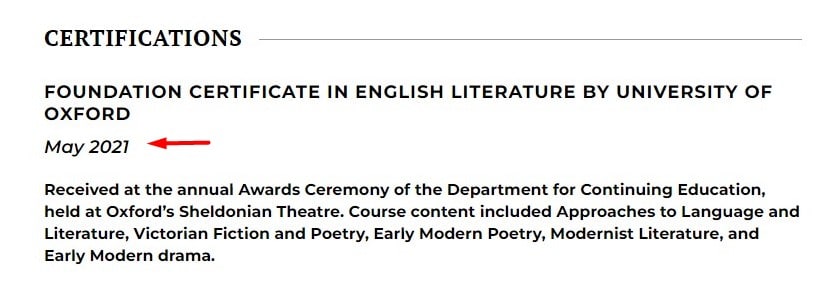
When adding months, make sure to spell them out and not use numbers (03 for March, for example). Using a number is not incorrect per se, but it might make it more difficult for ATS and recruiters to extract information.
Proper File Formats to Use for Saving Resumes
Here’s the final disambiguation of the phrase “resume format.”
Which file format should you use when saving your resume?
In short, it’s recommended to use a PDF file. It’s a safe bet, as your resume will look the same across all devices. Alternatively, you can use .docx , or another file format, if a recruiter requests it.
When saving your file, avoid random names such as “Resume_01.pdf” or “Resume_download_Mike”. Instead, list your name like this: “Mike-Davidson-Resume” or “Mike-Davidson-Operations-Manager-Resume.”
For bonus points, add the name of the company you’re applying to: “Mike-Davidson-Resume-Acme” will surely make the hiring manager feel that tiny bit more special.
FAQ: Additional Tips for a Flawlessly Formatted Resume
How long should my resume be.
Ideally, it should be a single page, especially if you have fewer than 5 years of experience and if you’re a recent graduate (or still a student).
If you’re experienced (5+ years), you can make it two pages long, but only if you feel it’s the only way to include what really matters.
The key thing to remember is that you can be detailed around positions that are relevant to the one you’re applying for; all others should not take up too much space and you can list only key things.
What’s the best file format to send my resume in?
As already mentioned, PDF. In rare cases when a recruiter asks you otherwise, you can use a .docx or .txt format, depending on what they want.
What about those super creative resume formats that go viral from time to time?
Yeah, we all remember that guy who styled his resume as a Google’s results page (he was applying to Google, you guessed it).
If you’re a highly creative person, like a graphic designer or a creative director, or similar, you might be tempted to showcase your design skills in your resume.
Still, it would be better to keep it simple. This is because you have ATS rounds to go through before a human eye looks at your resume. And even if you pass the ATS test, if your resume is too colorful it might be distracting or draw attention away from useful information.
So the best approach would be to keep it fairly simple and straightforward, and then include a link to your portfolio and showcase your genius there. 😉
What’s the best resume format in 2023?
The reverse chronological resume format is the best resume format to use in 2023. It’s the most ATS-friendly one, recruiters are familiar with it, and it’s candidate-friendly, as it lets you easily highlight your best achievements.
As a student, which resume format should I use?
Your best bet is the reverse chronological resume format with a slight twist: you can rearrange the work experience and education sections, placing education at the top, therefore highlighting your strongest points.
Maja Stojanovic
Turn interviews into offers
Share this article
- Big Interview
- Plans & Pricing
- Higher Education
- Editorial Process
- Resume Templates
- Interview Preparation
- Interview Q&A
- Career Advice
- Create an Account
- Knowledge Base
©️ 2024 Skillful Communications, Inc. | Big Interview is a trademark of Skillful Communications, Inc.
Terms | Privacy Policy

What’s the Best Resume Format for 2022? [+ Examples]
- February 15, 2021
- In Resumes & Cover Letters

It’s 2020 and time for a new job. You probably know you need to update your resume with your most recent experience and achievements. Did you also know you have to update your resume format? Things have moved on and you need to keep up with hiring managers’ expectations. In this article, we’ll help you understand how recruiters and hiring managers think. Also, we’ll take you through the choices you should make.
Table of content:
1. The resume format employers want to see 2. How to choose the right resume format 3. The chronological resume format 4. The functional resume format 5. The combination resume format 6. Things to keep in mind when choosing a resume format
But first, take our 2022 professional resume format quiz and see how many you score. For each question, mark yourself as a ‘Yes’, a ‘No’, or a ‘Maybe’.
Did you know?
- Only 1% of candidates get offered the job they apply for.
- The ‘look’ of a resume is at least as important as the content.
- Many employers simply won’t read an unsuitable resume format.
- 99% of applicants confuse resume format with resume style.
- 9% of people confuse resume format with resume formatting.
- 99% of people choose a resume format once and stick with it forever.
If you didn’t score 6 solid ‘yeses’, don’t worry, you’re not alone. Five minutes of thought, and making the right resume format choice, can lift you into the very top tier of applicants.
1. The resume format employers want to see
Recruiters and employers have one simple question in mind – “Does this applicant match our requirements?” Unfortunately, the time they’re willing to spend finding that out has become vanishingly small.
2. How to choose the right resume format
Recruiters and hiring managers simply want to see if you match what they need. As a result, they want information about you and they want it fast. Content is king. That’s because if you haven’t got what it takes they won’t consider you. Clearly, it’s all about showing that content effectively.
To do that, choose one of the three main professional resume formats. These are the:
- Chronological resume format;
- Functional resume format;
- Combination resume format.
3. The chronological resume format
Present your work experience in time order, but in reverse, to best use the chronological resume format. That’s because your most recent experience is the most important for employers to consider.
Use this format unless there is a reason to use one of the other two. That’s because readers know how to both scan and read this format quickly. Also, ATS (applicant tracking system) software deals well with this format.
Sections should typically show the following in this order:
- Contact details;
- A short profile summary;
- Current position;
- Previous experience;
- Qualifications;
- Other relevant interests or voluntary work.
If you add a sidebar, use it to summarize your skills or competencies.
It’s fine to use 2 pages but use page 1 to show your profile summary and current experience. Everything else should be on page 2 although do put your contact details on both pages.
- Career professionals with a continuous work history.
- People who have worked in the same field for many years.
- Individuals who show good career progression.
- Being sure applicant tracking systems (ATSs) will scan accurately.
Consider using it when:
- You’re not sure which resume format to use.
- You want to apply for a job in the same or a similar field.
- You can present a clear story of promotion from role to role.
- A format well understood by recruiters and hiring managers.
- It provides a full picture of your whole work history and background.
- An easy-to-read narrative of your career history.
- When you have significant or strange gaps in your work history.
- You’ve changed jobs frequently.
- Your work history does not show vertical progress.
- You’ve been unemployed for several months.
- You’d like to change your industry or sector.

4. The functional resume format
Unlike the chronological resume format, this format enables you to give priority to your capabilities for the job. Your experience gets pushed back, ideally right on to the second page. Some experiences may be completely excluded from your resume if they’re not relevant.
As a result, this format is sometimes called a skills-based resume format. It helps you present your main achievements and thereby demonstrate your strengths.
Be aware that some recruiters are suspicious when faced with a skills-based resume. That’s because they fear a candidate may be trying to hide something.
Sections should typically show the following:
- An extensive profile summary;
- A skills or competencies section (often within the profile);
- Selective work experience summary;
- An additional summary of work experience (often deliberately incomplete);
- People with limited work experience in the field.
- Individuals with several work history gaps.
- Those who are changing industry, sector or type of role.
- Applicants fresh out of college with a short work history.
- You are fresh out of college.
- You’ve had a career break due to pregnancy, illness, unemployment or a sabbatical.
- You have a broken history from frequently changing jobs.
- You particularly want to highlight your relevant and transferable skills as a career changer.
- Your significant achievements are spread across several roles.
- You’re an unconventional fit or not an ideal fit for the company.
- Competencies and transferable skills are emphasized.
- Attention is diverted away from your work history.
- Your most important accomplishments can be showcased
- Causing confusion after recruiters have been reading many chronological resumes.
- Recruiters becoming suspicious that candidates may be hiding or masking their background.

5. The combination resume format
Obviously, this is a mixture of both the chronological resume format and the functional format. Skills and work experience share the spotlight in this format.
It gives recruiters and hiring managers confidence. That’s because it ensures a timeline remains both visible and complete, after your profile summary.
Aim to show more skills and achievement content in your profile summary. A chronological resume format would show more in the employment section.
The advantage of this format is you have more space in the profile section to tell your story in a rounded and more compelling way. Additionally, you have more scope to show any added value you offer, over and above other likely candidates.
Sections should typically show the following, usually in this order:
- A medium-length profile summary, incorporating main relevant skills;
- Current job information;
- Previous work experience summary;
- Senior or executive management positions where it’s necessary to pick experiences from several roles held.
- People with a diverse employment history.
- Students and recent graduates.
- Professionals with strong achievements making a career change.
- You want to highlight both competencies and a strong history.
- You need more space to show or explain a story in your profile summary.
- You’re looking to change careers.
- You have a strong history but are re-entering work after a break.
- Any added value can be clearly presented.
- Both skills and work experience share the spotlight.
- A full work history is still visible to recruiters and hiring managers.
- Entry-level candidates and fresh graduates.
- Early-years career professionals.
- People who do not possess all the skills required for the job.

6. Things to keep in mind when choosing a resume format
Firstly, choose the format that’s correct for you. Secondly, add your content to build a compelling document. Thirdly, once it’s complete, follow the submission instructions specified.
- Think about the extent of your experience. This will help you to choose the resume format that is right for you.
- Think about your audience. Your resume may go through an applicant tracking system (ATS) initially. That means the chronological format is most easily read without errors. To make sure you include the right content, look at this best-practice advice .
- Don’t use gimmicks. Use a design that looks professional, not garish. Pick your fonts, colors, and any graphic elements to look classy. A template produced by a professional designer is a great starting point. Choose from classic, modern, or elegant styling. We have a large selection of templates for you.
- Do you include a headshot? This is a matter of personal choice. Sometimes a headshot is specifically asked for, in which case definitely add one. Our templates include variations to let you make the choice that is right for you. If you want more information on how to choose the right template, check out this article .
If you have a choice, submit your resume in PDF format. That’s because it will look the same on any machine or operating system. Also, it’s harder for a recruiter, HR person, or hiring manager to modify your resume before forwarding it.
Popular related posts:
- How to Make Your Resume, Cover Letter, and Linkedin Profile Work Together, and Help You Get The Job of Your Dreams
- “Why are You Leaving Your Current Job?“ 4 Best Answers
- How To Get a Job Faster With a Professionally Written Resume
- 23 Job Interview Questions to Ask an Interviewer
Do You Need to Hire a Professional Resume Writer?
Looking for a new job or thinking about a career change? You need a resume that’s going to open doors for you.

Jon Gregory
Jon Gregory is a highly accomplished professional with a diverse range of expertise in the career development field. As a respected and sought-after expert, he serves as a career adviser at Resumeway, a National Careers Week Ambassador, and a Careers Expert Member for The Guardian.
- No products in the cart.
- Resume Writing Service
- Free Resume Review
- Resume Templates
- Career Advice
- Create Resume
- Resume templates
- CV templates
- Resume Writing Service
- Best Resume Formats for 2024: Examples, Templates & Tips
- Resume writing /
Are you one of many job seekers who hope to find the perfect new resume format? Choosing the proper format can determine whether recruiters on LinkedIn (and elsewhere) decide to reach out to you. In addition, the way you lay out the resume determines what part of your history gets the most attention.
As such, there are three major resume formats to choose from. But, even after choosing one, there are other things to consider. We'll help you choose the suitable format and give you tips, examples, and templates to make creating your new resume simpler than you ever expected.
What Are the 3 Most Common Professional Resume Formats?
There are three specific standard resume formats that most people use. You can choose between reverse-chronological, functional, or combination as your basic resume format. The important thing is to choose one of the standard resume formats that best shows off your skills and work experience.
While popular resume formats come and go, you can count on these three options to be timeless. Learn more about each type and decide which works for your job application needs.
Reverse-Chronological
The reverse-chronological format is the most familiar to hiring managers. It's primarily focused on years of experience in similar positions to the one you are applying for. It includes a contact section, a professional summary, and information on work experience. For instance, job title, location, and role are included, along with your responsibilities.
This type of resume format is ideal when a company uses applicant tracking systems. You have lots of space to include keywords to peg you as an excellent potential employee. Skills and education are included but in a less prominent location.
When to Use the Reverse-Chronological Resume Format
Using reverse-chronological order is the best resume layout to show your work history. It's also highly ATS-friendly. This is the most common resume format and is the default if the other options do not work for you.
There are three specific situations where chronological resume format is the top choice:
1. If you are a job seeker who has been working in the same industry for many years.
2. If you are an applicant who wishes to show off their excellent career progression.
3. If you are a person looking to apply for an executive position.
Functional (Skills-Based)
The functional format puts a lot of emphasis on the skills section rather than work experience. This means showing off transferable skills for a career change or moving into a first job out of college, especially if you have done internships. Therefore, the summary statement and skills are the most essential parts of this resume.
You'll still include contact information and employment history, but the work experience has a lower priority than relevant skills, especially for career changers. A comprehensive list of skills is helpful here, similar to the work experience on a chronological resume.
When to Use the Functional Resume Format
As with the reverse-chronological resume, the functional (or skills-based) resume can be applied in various situations. However, it works best for certain potential employees applying for a position.
Some of the reasons you might choose a functional resume include:
1. If you are a job seeker who has little to no work experience.
2. If you are an applicant who wants to showcase their education and skills.
3. If you are an applicant who has several gaps in their work history.
Combination (Hybrid)
Finally, we want to talk about the combination resume format. This is a hybrid resume that works well for those who have a combination of work experience and relevant skills. The experience section is highlighted, but so are skills and achievements. You can think of it as a combination of a reverse-chronological and functional resume.
This gives you the chance to focus equally on work experience, an education section, and skills that make you stand out during a job search.
When to Use the Combined Resume Format
The combined resume format falls in between the two, making it suitable for someone who isn’t a high school graduate or someone with decades of experience. As a result, it's not as commonly used but still has its place in some situations.
Below are a few of the reasons you might choose a hybrid resume format:
1. If you are someone who is a job seeker that has worked in at least two jobs in the field.
2. If you are an applicant who has a well-rounded combination of experience and skills.
3. If you are someone seeking a job in a field where you have experience, but it was in the distant past.
Good Resume Format Examples
Now that you know the typical formats for a resume, you might be wondering how to make a resume yourself. Below, we'll share a few resume layout examples that you can use to create your own professional document. Then, you can look them over, download them for your own use, and find some inspiration to build the resume of your dreams.
Example #1: The Hybrid Resume
As a student, a simple resume format will be best. However, make sure to consider the job description to ensure you add any skills that you have from past jobs or hobbies you have had. Look here for more skills to put on a resume . This resume is in chronological order, but it also includes a lot of information on education and activities, so it acts as an excellent example of a hybrid resume.
The resume gives out all the needed information and delves deeper into some areas. This shows that the applicant is thoughtful and detail-oriented, which might stand out to a hiring manager. If you are new to work or moving into a different industry, this example gives an idea of what a great resume might look like.
Why Example #1 is Well-Formatted
The type of resume format is easy for a recruiter to read. The resume has a large header on top with the applicant's name. In addition, it has a left sidebar with extra information that is useful, especially for a younger applicant or someone just leaving school. For instance, it lists interests and languages to give an employer a better idea of the person applying.
In addition, this resume is well-formatted in terms of the main blocks of information. Therefore, the resume objective can provide a lot of information without being overly long. For example, job experience is included along with bullet points to explain regular tasks done. The resume also caps off with extracurricular activities, education, and references.
All in all, this is a well-rounded resume that would work for many people. Even non-students can use it to ensure they share all aspects of themselves, rather than focusing on past job experience.
Example #2: The Reverse-Chronological Resume
The following example is a resume for an automation tester , but it could easily be used for any career path. It has clear headings, provides plenty of information about the things hiring managers are interested in, and has a pop of color that might make it more eye-catching than monochromatic resumes or those with soft hues.
This resume is more along the traditional reverse-chronological lines with a contact section, resume objective, lots of work history information, followed by education, skills, and references. While the work experience is highlighted, the resume has a variety of information that gives more information about the applicant.
Why Example #2 is Well-Formatted
For a job application, this resume has a fantastic format. It's beneficial for sharing relevant experience for a position. It has all the information about past employers and utilizes a variety of bullet points that speak to what the applicant has done in the past. It's to the point and shows the person's skills and why they should get the job.
Since a reverse-chronological resume is the most common, this gives an idea of how to create your own. Whether using this template or something similar, it will get attention and make an employer more interested in you. That can often be enough to get you into an interview.
Example #3: The Hybrid Resume
As a hybrid resume, the last example delves into an applicant's skill sets. You can see information about their recent job and past education, but it has a large section for hard and soft skills, unique qualifications, and more. In situations where skills and employment are equally important, this type of resume can work exceptionally well.
Instead of placing the work experience front and center, the skills and qualifications come first. This ensures that a hiring manager reads those things and understands what you have to offer before your experience is used to supplement that. Likewise, hybrid or combination resumes work well when reverse-chronological and functional are too limiting.
Why Example #3 is Well-Formatted
Now that you have an image of the third resume example, you can see how professional experience and specific skills are in the mix. This resume starts out with a robust resume objective followed by qualifications. Along the side are personal details and a list of skills. The professional experience is farther down the resume but still informative.
These resumes are well formatted and ready to send to an employer. The only definite decision for you is which format looks best to you while showcasing your achievements. The following section will go into a bit more detail about that so you can make a decision and have an excellent start to your own resume.
How to Choose the Right Format for Your Resume
If you're asking, "What is the best resume format?" it depends on your experiences, skills, and education. The best format for a resume will vary by individual. Luckily, there are several resume styles you can choose from to show yourself in the best light.
First, be aware that most resumes have several of the same sections. In most cases, they will include the following:
· Your name and contact information
· A resume headline specific to the job
· Information about your past work history
· A list of some of your top skills
· Educational information such as your highest degree
· And a list of references the employer can contact.
Since all of these things are on every resume format, it might seem like it doesn't matter which you choose. However, that is not entirely true. It's crucial to select a resume format that matches your strengths and downplays any of your weaknesses.
It's not always easy to choose a resume format, so we want to offer some tips that might make the process easier.
· If you are seeking your first job or otherwise applying for an entry-level position, a functional resume is likely the top choice.
· If you have five or more years of experience, have worked in the industry at two positions, and are applying within that field, you will want to choose a reverse-chronological resume format.
· If you're leaving one career field and want to move into something new, there are two choices. The first is to choose a reverse-chronological resume format assuming you already have skills and experience. A hybrid or combination resume will be the top resume format if you do not.
Now that you understand resume formats, what great resumes look like, and which format suits your needs – it's time to get into some specifics. The following section is all about formatting tips you can use while creating your resume.
How to Format a Resume Properly? 5 Resume Formatting Tips
Something else to consider when you’re formatting your resume are which tips can make your document look even better. Even if you chose the ideal resume format for your experience level and the industry of the position, a few tips could make it even better. Whether you're going for a traditional or modern resume format, the resume tips below will ensure it looks great when a human looks at it.
Tip #1: Use Appropriate Margins
When it comes to resume writing, you need to consider the details. Along with getting writing tips, you also need to consider how the resume looks across the page. The readable space should fit all of your information within one to two pages. If you need more space, make the margins smaller. If there's too much space, make the margins larger.
It's a simple tip that can add a sense of elegance to your resume format.
Tip #2: Choose a Professional and Legible Font
When a hiring manager at your potential new job reads your resume summary, you want the words to flow well. That starts with selecting a professional and easy-to-read font. This can also be helpful if the resume goes through an applicant tracking system. However, thin or light fonts may be harder to read on paper or a screen, so they are best avoided.
Sans serif fonts, such as Calibri, Georgia, Helvetica, Avenir, and Corbel, are all excellent choices with clean lines.
Tip #3: Use the Right Font Size
In addition to font face, font size is also essential to consider. You'll want to choose a 10 to 12 point font in most cases. For short resumes, go with 12 points, while 10 points is great for longer resumes. Going larger can seem unprofessional, so you should avoid it if possible.
If the resume is still too long in 10 point font, it might be helpful to look for ways to streamline your information.
Tip #4: Add Headers
Using headers is a must. By making the font larger, bolder, or underlined, a hiring manager can easily find the information they want. There are several ways to do this. You can use the underline feature, make the headers 12 or 14 points, or bold the headers. In some cases, you can combine two or more of these to highlight sections and essential information.
These same tips can also be used for your contact information, so it's evident on the page.
Tip #5: Make Use of Bullet Points
Bullet points under your experience, education, and skills can make it easier to read the resume. Use them to list all your achievements, but avoid using only one or two if that's all you have to add. Simply list things with less than three parts in a sentence instead. But bullet points make things cleaner and more straightforward for a hiring manager to understand you. It also beats a long paragraph and is more likely to be read.
So use bullet points, at least in the work experience section, to break things up and make it easier to read.
Best Resume Formats: 9 Editable Templates to Download
Rather than creating a resume by hand, it can be quicker and easier to use a resume template. These already contain a professional resume format that you can apply your information to. Then, all you do is make a few edits, and your resume is ready to send out. It takes some guesswork out, requires you to do less formatting on your own, and makes the process streamlined so you can move on to other things.
There are tons of templates you can choose from, but we'd like to share a few well above average. You can use any of the resume examples below to ensure you are using professional resume layouts that will impact your application status.
Simple Resume Formats
A simple resume can be used for all sorts of purposes. It doesn't matter what industry you are in or what role you are applying for. These resumes are easy to read, simple to create, and provide all the information in clear terms. A few of the best resume formats for a simple resume are linked below:
Cashier Resume
Nursing Resume
Software Engineer Resume
Modern Resume Formats
Modern resumes are designed to have the same information as a simple resume, but it might be provided differently. A modern resume is a good option for high-tech jobs or positions that require knowledge of the latest practices. This kind of resume will be visually appealing and use the latest trends. You can see a few resumes that are modern in appearance and format below.
Computer Science Resume
Litigation Attorney Resume
Bank Teller Resume
Creative Resume Formats
Creative resumes can run the gamut from being a bit more colorful to including obscure information and sections. These resumes can be a bit of a risk but offer a big reward if the hiring manager appreciates the work. Choosing an unusual color scheme, adding a photo to your resume, or talking about your interests can elevate your resume to something more creative, like the options below.
Automation Tester Resume
Technical Writer Resume
Substitute Teacher Resume
Final Points About Job Resume Formats
The right resume format is the key to being noticed. It's the first thing you can do to ensure a hiring manager or recruiter has their interest piqued. In addition, it might make them interested in learning more about you – which could lead to getting the exact job you have been hoping for. When you use our resume builder , the process is simple, quick, and avoids a significant time investment.
Just remember that a resume is only part of the puzzle. Even the best resume format and structure has to be held up by other application documents, like a cover letter and references. However, once you have a great format, a cover letter, and have filled in your details, you can move closer to the job you want!
Which format do most employers prefer for resumes?
A reverse-chronological job resume format is the most common. This is because employers are used to and comfortable with it. However, functional and hybrid resumes are also standard and won't seem out of place. Any of the three will look just fine to the average hiring manager.
How do employers look at resumes?
Many employers skim resumes for keywords based on the job description. Therefore, it's essential to include education, experience, and skills that fit the job you want. Only after seeing that you're qualified will a recruiter read more deeply. Remember, your resume is only read for 60 seconds or so in most cases.
What is the best layout for a resume with no or little experience?
A functional resume is your best bet when you have little to no experience. This resume format lets you talk about skills and education more than work experience. Listing all your skills and sharing your education can show that you are qualified for a job.
What are the most common mistakes in resume formatting?
Spelling errors, bad grammar, making the resume too long, or being unoriginal are common resume formatting mistakes. After making a resume, it should be read to ensure everything looks perfect. Editing mistakes and being thorough shows you care about your image and are serious about the position you're applying for.

Should you have a picture on your resume?
It depends on the type of resume, but usually, a picture is not required. A photo often offers no benefits. In addition, it can introduce bias in the job application process. Unless a photo is asked for and makes sense for the job, it's better not to include one.
Related articles
Aviation resume example, template, skills, objective & writing guide for 2024.
For job seekers aspiring to secure a position within the dynamic field of aviation, crafting a...
Uber Driver Resume Example, Description, Skills & How to Write Tips for 2024
Crafting a standout resume is crucial for job seekers looking to drive for platforms like Uber and...
Lifeguard Resume Example, Description, Skills & How to Write Tips for 2024
Crafting a compelling lifeguard resume is a crucial step for anyone aspiring to safeguard the lives...
More than 112.872 users have already made their resume
With CV maker, you can quickly and easily create a distinctive and professional resume within 15 minutes.
In this article, we will discuss the three most popular professional resume formats and how to use each of these resume formats to put forth a competitive job application. During your research and brainstorming process, make sure to look at resume templates and resume format examples, as well as resume templates for word, resume templates for google docs, and resume templates for free.
Depending on the nature of your career and professional background, you may prioritize finding professional resume templates or simple resume templates. Use whatever works best for you!
Professional resume formats and resume templates
There are lots of factors to consider when putting together your ideal resume . Your resume is your one chance to make a good first impression and land an interview. In order to create a solid, professional resume that is reflective of your skills and qualifications is tailored to the specific job listing, is compatible with Applicant Tracking Systems (ATS) technology, and brings you the attention you need to land an interview in a competitive job market, you’ll need to do your research! Look at sample resume formats to get a better idea of what will work best for you.
Perhaps the most efficient way to write a competitive, professional resume, is to use a professional resume builder or one of the best resume templates in 2022, easily available online. You may even consider using a resume template with a cover letter included.
Chronological resumes
The best, most popular resume format is the chronological resume . This professional resume format is written in reverse chronological order — listing your most recent employment history first and ending with your most-dated employment history.
This resume format for jobs is considered standard and is most favored by job recruiters and hiring managers. This is because these resumes are clear, concise, easy to read, and follow an overall narrative. The other benefit of writing a chronological resume is that this type of resume is readily interpreted by Applicant Tracking Systems (ATS), a popular hiring tool used by the majority of companies.
Functional resumes
Another professional resume format is the functional resume . A functional resume is a more innovative resume format that focuses on job skills instead of on employment history. This can be helpful for young professionals, people changing careers, as well as for workers with gaps in their employment history. A functional resume allows job seekers to craft a compelling narrative as to why they would be a unique asset to the company by focusing on their passion, initiative, and overall professional job skills.
The potential downside to a functional resume is that a job recruiter or hiring manager may be suspicious of this format. They may wonder if the applicant is trying to hide something, such as potential gaps in employment or a lack of industry-related work experience. Overall, functional resumes are a bit more creative and rare. They certainly have their time and place; just be aware that they are not as standard and as a result, are not as immediately accessible to hiring managers and job recruiters.
Hybrid resumes
The final professional resume format is the hybrid resume . There is no one correct way to write a hybrid resume. A hybrid resume combines elements of chronological and functional resumes. For many job seekers, chronological resumes hold a lot of appeals, but still, something is appealing about the innovative functional resume format. Due to this, many job seekers alter their resumes to further highlight job skills and other more creative, project-based credentials. This resume format is referred to as a hybrid resume.

What format should I write my resume in? The different types of resume formats
What format should I write my resume in? Click here to read more

What is an ATS (Applicant Tracking System)?
Find out more about the inner workings of an Applicant Tracking System. Click here to read more
Applicant tracking systems
Something else to consider about functional and hybrid resumes is that Applicant Tracking Systems (ATS) cannot interpret the data as efficiently. Therefore, your credentials, job skills, and work experience may be categorized and stored incorrectly. With the rise of Applicant Tracking Systems technology and online job listings , it is crucial to submit a resume that is compatible with these technologies. Otherwise, you risk having your resume overlooked, despite your overall qualifications.
Using professional resume builders and resume templates
Resume templates are an invaluable resource for job seekers because they ensure that you will follow professional resume formatting standards. By choosing a job resume template that is well-suited to your needs, you will be able to demonstrate your unique qualifications in a way that is clear and concise, while simultaneously ranking well in the company’s hiring database (created by its Applicant Tracking System) and impressing your future employers.
Tips for writing a professional resume
While you put together your ideal resume, make sure you follow professional resume standards. Here’s a checklist to keep in mind as you get started:
While it is important to always be mindful of these tips, especially as they relate to your overall formatting, professional resume templates will help give you a jump-start. With the help of a professional resume template, you will have a streamlined, professional resume.
Popular job trends in 2022
The job market in 2022 has continued to evolve since the beginning of the pandemic in 2020. Not only have industries been forced to adapt to these unprecedented times, but workers’ standards and priorities have shifted significantly. There have been more job openings than job seekers in recent years. Effectively, this has increased workers’ collective bargaining power. Overall, workers are increasing their workplace standards, especially in regards to healthcare coverage, benefits, pay, and the option for more flexible hours.
Remote or hybrid work
Since the beginning of the pandemic in 2020, workers have begun to favor remote or hybrid work environments. These environments eliminate many workplace stressors, such as long commutes and transportation factors, as well as interpersonal office dynamics. In fact, according to studies, workers tend to be more efficient and productive outside of an office setting.
Many workers favor the freedom and flexibility that accompanies remote or hybrid work and are motivated to complete their work on time. In terms of overall job trends of 2022, many anticipate the rising popularity of the 4-day workweek. This is largely due to the increased efficiency of remote and hybrid work environments.

Hybrid Remote Work Models: What Are They & How They Differ
Each of these work-styles have their own set of advantages and disadvantages. Click here to read more
Self-employment and “gig work”
Workers are also increasingly gravitating towards self-employment, with the “gig work” economy currently on the rise. Through gig work, workers are realizing the true monetary value of their time, effort, and skill set. Professionals are learning to ask for, and expect to be paid for, their true monetary worth. Gig work has also presented itself as a powerful possibility for supplemental income.
What to keep in mind about 2022 job trends
Remote and hybrid work environments are an important 2022 job trend to keep in mind for recruiters and job seekers alike. This is because companies are able to hire from a more diverse applicant pool. Physical location no longer plays such a crucial role in the hiring process. Now companies and workers can enjoy more options and overall flexibility. This also means, however, that workplace competition is also on the rise. Overall, this is why it is becoming increasingly important to learn how to write a professional resume and cover letter and to make sure that your LinkedIn profile is up-to-date .
Consider using a professional resume builder or resume template when applying for jobs. You may also choose to hire a career coach. Reach out to learn more about our resources as you move forward with your job search and job applications.
- May 6, 2022
Career Coaching
Best resume templates in 2022.
Contact a Prepory college admissions coach and start your college admissions journey.
Our college admissions experts are here to guide you from where you are to where you should be. Through our comprehensive curriculum, individualized coaching, and online workshops, you are set for success as soon as you connect with us.
During our initial consultation, we will:
- Assess your student’s applicant profile and higher education goals
- Provide detailed information about our services and programming
- Share tips on how to navigate the U.S. college admissions process
Let's get started!
Land your next great job with a Prepory career coach!
Let us help you advance your career, Identify new opportunities, participate in mock interviews, build, thrive, grow, and land your dream job.
Subscribe to our blog!
Follow us on social media
Want to get admitted to your dream school or accelerate your career?
College Admissions
(929) 244-3365 [email protected] 12555 Orange Drive, Suite 100A, Davie, FL 33330

Copyright © 2023 Prepory Coaching Group LLC. All Rights Reserved.
Ready to take the next step towards college admissions or career success?
Book your free consultation.
Modern Resume Templates
The easiest way to bring your resume into the 21st century - with these contemporary and timeless resume designs that won't need to be updated for years to come.

Browse templates by resume style
Mix & match unlimited theme, font and color combination..

Use our suggestions to complete your resume 5x faster.
what is a modern resume.
Modern resumes have sleek designs that convey a sense of calm collectedness. These resumes are fresh and bold with elegant fonts and clean lines. Colors are incorporated in tasteful moderation, boasting creativity while still maintaining a high degree of professionalism.
Modern resumes help you appear contemporary and trendy. This is great if you’re applying to a relatively new company or one that has a contemporary culture.
Tip: Use colors in a way that highlights important parts of the resume without making it hard to read. For example, the body of the resume should always be black, but use blues, greens, purples, or even reds to color the titles of your sections. For more information on when to use colors — and which colors are appropriate — read our advice for choosing colors for your resume.
When to use a modern template?
As mentioned above, individuals applying to new companies, such as startups, or to companies with a young audience or product should use modern resumes. Similarly, professionals in the tech, IT, marketing, design and media fields can benefit from modern resumes.
Modern resumes are also ideal if you’re looking to present yourself as fresh and innovative. The bold, stylish designs will capture a recruiter’s attention and may even buy your resume a few more precious seconds of their attention.
Tip: A modern resume template can pique a recruiter’s interest, but keeping it there can prove tricky. Use strong action verbs to detail your work experiences and skills. For ideas, check out our list of action-packed verbs .

10 key points of a modern resume format
- Color. Modern resumes rely on striking colors such as blue, green, and purple to highlight important pieces. This keeps the recruiter organized and attentive while reading.
- White Space. The resume body is evenly balanced by the white space. Since modern resume templates employ bold design elements, standard margins and clean space keep the sections clear and legible.
- Stylish Fonts. The fonts are tastefully fashionable, helping the resume glitter amidst its duller brethren. These fonts also provide an air of freshness while still maintaining professionalism.
- Strong Header . Modern resumes make your name and contact information the center of the resume. This bolded or flashy header demonstrates your confidence and reminds the reader of your credentials (i.e., doctor or CPA).
- Headshot or Logo. Many modern resumes include a headshot or logo in order to develop personal branding. This also reminds the recruiter that you are indeed a real-life person, which can help you feel more relatable.
- Room for Experiences. The modern resume strategically uses design elements in order to amplify the body of the resume itself. This means your work experiences become the focal point, and you should list all relevant certifications and education experiences.
- Strong Verbs . Since the main focus is on what you’re saying, you need to use strong verbs that convey your abilities. Check out our list of 350+ action verbs to make your resume more effective .
- Clean Lines. The modern resume template incorporates lines and other design features in order to organize the resume. These elements break the resume sections into chunks, which improves readability and saves the recruiter from feeling overwhelmed.
- Hobbies. Modern companies claim to be interested in who “you” are as a person in order to see if you fit their culture. This means you can list a few relevant hobbies on your resume. For example, if you work in the marketing industry, note that you enjoy art or reading. For more information, check out How to Include Hobbies on Your Resume .
- Profile Summary. Write a concise summary about your qualifications and how it relates to the position you’re seeking. The modern resume template places this summary at the top so as to catch the attention of the recruiter and entice them into reading the rest of your resume. So, it’s imperative that your summary sparkles!
Where to download a modern resume template?
Easy Resume offers a variety of modern resume templates suited to all industries and levels of experience.
For more help writing a resume, look no further than our guide on How to Write the Perfect Resume in 2020 .
Get a head start with one of our resume examples

Facebook • Twitter • Linkedin • Pinterest • Crunchbase
3 Best Resume Formats for 2024 [W/ 5+ Professional Templates]

How you format your resume matters .
When reviewing your resume, the first thing hiring managers notice is how your resume looks , not what it contains .
And if the first thing they see is a messy, cluttered, crowded resume, chances are you won’t make a great first impression.
So, this begs the question: what are the best resume formats, and which one should YOU use?
That’s exactly what we’re here to explain! In this article, we’re going to cover:
- Resume Formatting Guidelines
- 5+ Resume Templates (You Can Steal)
- 3 Main Resume Formats (With Examples)
- Resume Format Pros and Cons
- How to Choose a Resume Format
- 7 Other Resume Resources
Let’s dive right in!
Resume Formatting Guidelines
If you’re formatting your resume from scratch, you’ll first want to pay attention to the layout.
That involves setting the margins, picking the font size, and determining your resume’s length.
To create a professional-looking resume, follow these general formatting guidelines:
- Don’t make your resume longer than one page . Unless you have 5+ years of relevant work experience, there’s no reason for your resume to be two or three pages long.
- Pick an 11 or 12-pt font size and stick with it throughout your resume.
- Pick an attention-grabbing (but professional) font . We recommend Ubuntu, Roboto, or Overpass.
- Use standard and legible resume sections . For example, your work experience should be called just that “Work Experience” and not “work history” or something else.
- Leverage bullet points to list information such as work achievements and responsibilities, academic details , etc. They help make the resume much more reader-friendly.
- Be consistent with resume formatting (e.g. use the same date format everywhere, instead of using 11.2018 in one place and November 2018 in another).
- Have good line spacing. You don’t want the information on your resume to look all cramped up.
- Always save your resume as a PDF file . It’s the safest choice, as it guarantees your resume layout will stay intact no matter what device opens it. Only save your resume as MS Word if the job you’re applying for specifically requires you to and never, ever, submit a JPEG or PNG of your resume.
New to resume-making? Give our resumes 101 video a watch before diving into the article!
6 Free Resume Templates (You Can Start Usign Now!)
Formatting a resume from start to finish can be a time and energy-consuming process.
If you’re building your resume with Word, for example, you’ll have to spend at least an hour tweaking the margins, making the headers and body text uniform, picking a font, and so on. You’ll spend an hour or two before you can even start filling in the resume contents!
And if all of that wasn’t enough, one misplaced sentence here or a wrong click there, and your resume layout starts spilling over to page 2!
Want to skip all the hassle of resume formatting? Check out some of our free, tried-and-tested resume templates , pick out your favorite, and fill it in as you go:
#1. Basic Resume Template

Good for conservative, traditional industries.
If you want to focus on your resume’s contents rather than its design, then the Basic template is for you. With a concise and well-organized layout, this resume format highlights everything the hiring manager wants to see.
#2. College Resume Template

Good for university students, recent graduates, and entry-level professionals.
If you’re applying for internships or entry-level jobs, you’ll want to show off your skills, academic achievements, and whatever work experience you have. Well, that’s exactly what this template does!
Not to mention, its contemporary style is perfect for younger candidates who want their resume to be as visually appealing as it is professional.

#3. Executive Resume Template

Good for senior executives who may be applying in creative or green industries . While very professionally formatted, it also shows off a tinge of personality with its blue color scheme.
#4. Modern Resume Template

Good for professionals in the business world or IT industries.
Square brackets, bullet lists, infographics, and icons work together in this template to attract the hiring manager’s attention and get them to go over your work experience and achievements in depth.
#5. Creative Resume Template

Good for anyone applying to creative industries such as marketing , design, publishing, and entry-level professionals.
If you’re looking to stand out visually as much as through your skills and achievements, this is the template for you. Creative is designed to be a stylish resume that makes a stunning first impression while remaining professional.
#6. Simple Resume Template

Good for senior professionals with a lot of work experience who are in conservative industries such as law or banking.
The well-organized and professional formatting in this resume template is visually modest, allowing your achievements to do the talking.
What Are the 3 Main Resume Formats?
Now that we covered all the basics, let’s talk about resume formats in detail .
The first thing you want to know is that there are three main resume formats out there, namely:
- The reverse-chronological resume format. This is the most common and practical resume format in 2024.
- The functional resume format is also known as the skills-based resume format.
- The combination resume format , or hybrid resume format, is a combination of the other two formats.
At this point, you’re probably asking yourself how these 3 formats are different from each other.
Well, the main difference is that they focus on different parts of an applicant’s experience by listing sections in different orders.
Here is what we mean by that:

So, in a nutshell:
- The reverse-chronological resume format focuses on your work experience , listing them from most to least recent.
- The functional resume format focuses on your skills that are relevant to the job.
- The combination resume format focuses on your experience and skills by aiming to prove that you possess the skills you list through your work achievements.
What’s the Best Resume Format For Me?
So far so good - you now know all about the three main resume formats and how they’re different from each other.
Now, you probably want to know what the optimal format is for YOUR resume.
Well, mainly, that depends on what point you’re at in your career. Meaning:
- If you’re a seasoned professional or if you’re looking to get hired in an industry where you have tons of experience, you should pick the reverse-chronological format.
- If you’re applying in a creative industry or for a position that prioritizes your skillset instead of your work history, then you can go for the functional resume format.
- If you’re looking to get hired in a position that requires both experienced and skilled applicants, then the combination format is your best bet.
And now, let’s go over each resume format to see how you can use them to your advantage, based on some real-life examples:
#1. Reverse Chronological Resume Format
As we mentioned before, the reverse-chronological resume format is the most popular format in 2024.
It usually looks like this:

The main thing about this resume format is that it’s useful for practically every job-seeker.
The reverse-chronological format has a very simple structure, it’s easy to skim, and overall, it’s the most popular format around the globe.
For this reason alone, we typically recommend using this format to most people - even if using one of the other formats also makes sense.
Here’s what you’d include in a reverse-chronological resume:
- Contact Information - Your name, phone number, location, and email address. In some cases, you can include useful links such as a LinkedIn or GitHub profile.
- Resume Summary or Objective - A brief 2-4 sentence summary of your work experience, or your objective for applying for a given position.
- Professional Title - Your title. This should mirror the exact position you’re applying for.
- Work Experience - Your work experience in reverse-chronological order. When possible, talk about achievements over responsibilities.
- Skills Section - Skills relevant to the position you’re applying for.
- Education - Your educational history. Pro tip - if you have a B.A., feel free to skip your high school education.
- Optional Sections - Sections like volunteering, projects, portfolio, hobbies , etc. While they’re not a game-changer, they can help fill up some space on your resume.
As we already mentioned, this resume format primarily focuses on the one part that’s relevant to most hiring managers - your work history .
As such, the key to making the most out of this resume format is nailing the work experience section. To do that, here’s how you should structure it:
- Start with your most recent job and go backward from there.
- Tailor the section to the job description. This means that you shouldn’t list every job you ever worked - only the ones that are relevant for this one.
- For each job that you list, include your job title , the name of the company, the location, and the time period you worked there.
- Below, add four to five bullet points for recent jobs and two to three bullet points for earlier jobs.
- Focus on your achievements instead of your responsibilities. Hiring managers already know the basic responsibilities of the jobs they’re hiring for. So, rather than your responsibilities, they want to learn about your achievements.
- Whenever possible, quantify your achievements. Facts and numbers are more convincing than words.
- Use action verbs and power words . (E.g. “created” instead of “was responsible for creating” ).
Reverse-Chronological Format Example
As we already mentioned, the best thing about the reverse-chronological format is that it’s a great choice whether you’re an entry-level worker or a seasoned professional.
Any relevant experience you’ve got, the chronological experience will highlight effectively.
For example, here’s a digital marketer’s resume work experience section created using the reverse-chronological format:
Digital Marketing Manager
Wonderfull Agency Inc.
06/2017 - Present
- Created a new format for reporting and presenting the sales, customer engagement and Google Ads reports that decreased the number of meetings by 24% in the last three quarters.
- Updated and monitored the Bid Strategy in Google Ads and Bing Ads which resulted in a CTR increase of 3.2% in the first month.
- Redesigned the webpage UX, decreasing customer turnover by 25% within a period of two months.
- Conducted keyword research for updating the product pages on the online shop, increasing the organic keywords in the Top 100 by 5.600 and in the Top 10 by 315 for high-volume searches.
Digital Marketing Specialist
Company X
02/2015 - 05/2017
- Collaborated with a copywriter and designer to update landing pages based on search intent, increasing conversion rates by 20% on average for select clients.
- Worked directly with company clients, handling their Google Ads accounts.
- Managed a total of $40,000 in ad spend per month.
- Achieved an average of 200% ROAS overall ad accounts.
Reverse Chronological Resume Format Pros & Cons
Still not sure if the reverse-chronological resume format is the right choice for you? See our pros and cons below!
- Recruiters and HR managers prefer this format.
- It will definitely “beat” Applicant Tracking System (ATS) software.
- Provides a reader-friendly chronological history of your work experience.
- The most popular resume format in 2024.
- You need to make your work achievements stand out to catch the recruiter’s attention.
- Hard to fill in for a recent graduate with no work experience.
- Makes career gaps very obvious. If you’re a career changer, you need to explain those employment gaps on your resume.
#2. Functional Resume Format
As we already mentioned, the functional resume format is also known as the skills-based resume format. Here’s an example of what it looks like:

As the name suggests, the functional resume format focuses on your skills and your key strengths.
In a nutshell, this resume format takes the spotlight away from your work experience by highlighting what you’re good at instead.
As such, this resume format is perfect for recent graduates or career changers who have little-to-no experience in a particular field.
Here’s what to include in a functional resume:
- Contact Information
- Resume Summary or Objective
- Professional Title
- Skills Summary
- Additional Skills
- Work Experience
As you can see, the main difference from the reverse-chronological format is that the focus of the functional resume is the skills summary and the resume objective that’s placed right at the top of the resume.
Here is exactly how you should write them to impress the hiring manager:
- Use your resume objective to state your career intent and explain what makes you the ideal candidate for the job.
- Start off your resume objective by mentioning a skill, education, or certification relevant to the job, mention the responsibilities you could handle, and include your motivation for working that particular job.
- In the skills summary, include four or five skills that are most relevant to the position.
- Instead of just listing your skills, be descriptive. In bullet points or in plain paragraphs, give examples of how you applied these skills in practice and try to make them as quantifiable as possible.
Functional Format Example
Let’s assume that you’re an entry-level journalist.
Since you graduated, you’ve worked as a part-time intern at a magazine and published a dozen articles online and in print. You also run a blog that has a modest but loyal readership.
Now, you want to apply for an actual journalism position at a recently founded newspaper. So, you’re using the functional resume format.
Here’s why it’s the right choice:
- It highlights your skills. In this case, you don’t have the experience to apply for the job, but you may have all the right skills.
- It allows you to prove your skills. There’s ample space to show exactly how you can put your skills to use for the upcoming job.
Now let’s see what your resume objective and skills summary (or areas of strength) would look like in this case:
Resume Objective
Driven and hardworking journalism graduate looking to get hired as a reporter in The Daily Prophet. I interned at Who Magazine for six months, where I gained hands-on experience in research, fact-checking, and interviewing. Passionate blogger at Fake Blog Website, which is currently followed by over two thousand readers.
Skills Summary
Research & Fact checking
- Able to systematically look for information, resources, data, etc. through a variety of sources, such as books, online directories, or social media.
- Careful to always ensure that every claim and data that gets published is accurate and legitimate.
Interviewing
- Full knowledge of journalism ethics and standards that are required to conduct successful and dignified interviews.
- Skilled at connecting with interviewees on a deeper level to ensure comprehensive and detailed interviews.
- Excel at several types of journalistic writing, including news, feature writing, columns, and reviews.
- Have published over 15 articles in different newspapers and magazines since graduating.
Considering that the functional resume focuses solely on a candidate’s skills, the only groups of candidates who should consider using it are:
- Freelancers with impressive portfolios
- Professionals in creative industries
- Career changers
- Recent graduates, and entry-level professionals
- Military veterans passing into civilian roles
So, to sum it all up:
Functional Resume Format Pros & Cons
- Good for highlighting specific skills.
- Useful if you’re switching careers since you can explain how your skills transfer to the new job.
- Useful if you’re a recent graduate with practical skills but not much work experience.
- The functional resume format is not very popular in 2024, and most recruiters and hiring managers aren’t familiar with it, so using this format carries a bit of a risk.
- Since the functional resume has less focus on work experience, recruiters might think you’re trying to hide something.
- Applicant tracking systems (ATS) have difficulties reading functional resumes.
#3. Combination Resume Format
The combination resume format , also known as the “hybrid,” is a mixture of the functional and the reverse-chronological format.

This resume format gives equal attention to an applicant’s skills section and work experience. As such, you end up including both the Skill Summary and the Work Experience sections:
- Skill Summary
The focal point here is the skills summary. Placed right after the contact information section, this is where you list the skills that are required for the job and then prove that you have them through your professional experience and achievements.
Here is exactly how you should write it:
- List the skills that are required for the position you’re applying for and that you actually possess.
- Add up to 4 professional achievements underneath each skill to prove that you possess it.
- Make your achievements as descriptive and quantifiable as possible.
Combination Format Example
Say you’re a senior program manager with over a decade of experience in your field.
You can plan, execute, evaluate programs and projects across diverse industries, and inspire your team to do great work.
Recently, someone told you about an opening for a program director in an international company. To apply, you’re putting together a hybrid resume format.
Here’s what makes it the best choice:
- Saves space. For highly competitive positions, you want your resume to be able to cut through the noise. The hybrid format allows you to do that by bringing into focus your most relevant achievements right from the start.
- Combines the best parts of the other two resume formats, which is perfect for senior professionals or executives that have plenty to show for both experience and skills.
For example, some of the skills required for the program director gig mentioned above may include interpersonal skills , budget management, and project management.
Here’s what the skills summary in your hybrid resume would look like in practice:
Interpersonal Skills
- Initiated formal and informal coaching and mentorship to 50+ team members regarding project charter development, resource planning, best practices of project management, and appropriate delivery of project outcomes.
- Coordinated all project inputs with several functional/technical directors, managers, and project core teams, to formulate appropriate project tools and methodologies.
Budget Management
- Oversaw the implementation of the enterprise’s multi-year, multi-million dollar research system software that benefited employees company-wide.
- Analysis of financial and statistical data reduced operational costs by 12%.
- Strategically supervised the project execution teams to ensure the timely and cost-effective completion of projects, saving the company $250K in project costs.
Project Management
- Provided strategic direction, leadership, and project governance for a multimillion-dollar application project portfolio, which successfully supported a population of 60K+ end-users across the UAE and Saudi Arabia.
- Streamlined project management methodologies and communication in the IT division, which increased efficiency by 90%.
- Accurately report on project status throughout its life cycle to 20+ project teams, stakeholders, and sponsors, encompassing budget estimation, scheduling, and resource planning.
Combination Resume Format Pros and Cons
- Allows you to show off more of your experience and skills using less space.
- Useful for very senior professionals or executives who need to highlight more than just their work experience.
- Good for applicants who may have a noticeable employment gap but plenty of work experience nonetheless.
- As with the functional resume format, applicant tracking systems have difficulties reading combination resumes.
- If you’re a recent graduate or don’t have much work experience, this resume format is not very useful.
- As is the case with the functional resume, most hiring managers aren’t very familiar with this format, which might cause some confusion in the process.
The Verdict: What Is the Best Resume Format?
Now that we’ve covered all 3 of the common resume formats, you’re probably wondering which one's best resume format out there .
Here’s our verdict:
In 90%+ of the cases, we’d recommend going with a reverse-chronological resume format.
In 2024, it’s the most common and useful format:
- Applicant tracking systems can read it without any problems.
- All recruiters and hiring managers are familiar with this format.
- Whether you’re a recent graduate or a senior professional, it’s the easiest format to work with.
So, even if you’re a career changer, a highly-qualified professional, or a college student, it’s risky to choose one of the other two formats over the reverse-chronological one.
There’s a good chance that the applicant tracking system won’t be able to read your resume and automatically discard it - after all the time you put into creating the resume!
At the same time, recruiters might just not be familiar with these resume formats, or think that you’re just trying to hide the fact that you’re not experienced, and disqualify you based on that.
So, the rule of thumb - when in doubt, go for the reverse-chronological resume.
Looking for CV writing tips instead? Here's our full guide on how to write a CV !
How to Beat the ATS Software
Did you know that 75% of resumes don’t even make it to the hiring manager ?
Instead, they get scanned by ATS software, which evaluates your resume and decides whether it’s relevant enough for the hiring manager to give it a look.
At first, ATS software was used by larger companies that receive thousands of applications daily as a way to filter out irrelevant applicants. Today, though, studies show that most companies use ATS to evaluate applicants.

As worrying as this thought may be, you’ll be glad to know there is a way to beat ATS and get your resume on top of the hiring manager’s desk:
Creating an ATS-friendly resume !
Here is a handy list of our top tips for making a resume that beats applicant tracking systems:
- Place your contact information at the top of your resume.
- Sprinkle specific keywords from the job description throughout your resume.
- Avoid using graphics or charts as part of your resume.
- Save your resume in PDF format.
7 Other Resume Resources
Picking the right resume format is just the first step in creating a convincing resume.
Want to learn how to make a resume that lands you the job?
Check out some of our best career resources!
- Job Search Masterclass - This one’s our flagship e-book. It covers literally everything you need to know about job-search: how to make a resume, how to write a cover letter, how to apply for jobs effectively, what are the most common job interview questions, and a LOT more. The book is jam-packed with value, and illustrated, making it an extremely easy read.
- How to Make a Resume - Our comprehensive guide on how to make a resume from A to Z.
- Interview Questions And Answers - Have a hard time with job interviews? This guide features ALL the most common job interview questions that you might encounter.
- How to Write a Cover Letter - Our ultimate guide on writing a cover letter (free templates included!)
- 50+ Resume Examples - Need some inspiration with your resume? Check out our resume examples for 50+ different positions and fields.
- 43+ Resume Tips - A complete list of all our resume tips, ordered by importance.
- 26+ Interview Mistakes - Whatever you do, avoid making these common interview mistakes.
And of course, for more industry-leading job-search advice, make sure to follow our career blog !
FAQ on Resume Formats
Do you still have some questions about resume formatting? We’ll get them answered here!
1. What’s the best resume format in 2024?
For the majority of job-seekers, the best resume format in 2024 is the reverse-chronological resume format. This resume format involves listing your resume information (e.g. your work experience and your education) starting with the most recent one and going backward through relevant jobs, degrees, or qualifications.
Here’s why the reverse chronological resume format is the best choice:
- It’s easy to read and skim through
- Hiring managers are familiar with it because it’s the most commonly used one
- It’s ATS-friendly, which means Applicant Tracking Systems can scan it with ease
- It brings your career progression and professional achievements into the spotlight
2. What is the correct format for a college student resume?
The best resume format for a college student resume is the reverse-chronological format .
While it is true that a functional resume can help you emphasize your skills more than work experience, it comes with two serious problems:
- Recruiters aren’t familiar with it, and they might think you’re trying to hide the fact that you don’t have work experience.
- Applicant tracking systems have trouble reading this resume format.
So, unless you have absolutely no experience to show for it (meaning, not even unpaid internships, or even college projects with relevant responsibilities for the job you’re applying for), then you should still choose the reverse-chronological resume format over the skills-based one.
If you’re worried about your lack of work experience , don’t. For most entry-level positions and internships, you’re not required to have work experience.
3. What is the best resume format for a job seeker with experience?
The best resume format for a job-seeker with plenty of experience in the industry they’re applying for is the reverse-chronological format.
Here’s what makes the reverse-chronological format the best choice:
- It puts emphasis on your strengths as an applicant, namely your professional experience.
- It shows recruiters exactly what they’re looking for (your achievements and qualifications) from the get-go.
4. Is resume format important?
Yes, the resume format you choose is important. Basically, the resume format involves the type of information listed on the resume and the way this information is organized and presented.
When they’re evaluating your resume, hiring managers expect to see information that will help them assess whether you’re the right person for the job (i.e. your experience, skills, and qualifications, among others). If, for example, you have five years of work experience but your resume format focuses on your education, the hiring manager may have trouble realizing that you’re the right person for the job.
At the same time, hiring managers want to spend as little time as possible reading your resume. This means that a disorganized, chaotic resume may get them to throw your resume in the “rejected” pile without giving it a second thought.
That’s why it’s super important to choose the right resume format that highlights your strengths and that recruiters know and like.
5. What is an ATS-friendly resume format?
Applicant Tracking System software is software that companies use to sort through the countless applications they receive daily.
What ATS does is scan resumes for specific keywords mentioned in the job description (e.g. necessary skills for the job), and filter out those applications it deems irrelevant.
As such, an ATS-friendly resume format is the kind of format that lists information in plain text and organizes it in clear sections, making it easier to be read by applicant tracking systems.
This is important because ATS software is typically unable to read text within images or scan infographics.
6. What resume format is most ATS-friendly?
The most ATS-friendly resume format is the reverse-chronological format.
That’s because it allows you to use ATS-specific keywords in your skills section and doesn’t use too many visuals such as graphs, infographics, etc.
7. Are hand-written resumes still used?
No, hand-written resumes are barely used in 2024. As such, you should not submit a handwritten resume when you’re applying for jobs.
Here are some of the most important reasons why:
- ATS software is unable to scan hand-written resumes. This means that if the company to which you’re applying uses an ATS, your resume will get disqualified.
- Your handwriting might be difficult to understand. Not just that, but you’ll have trouble differentiating one section from the other and keeping everything uniform, which means your resume will be the opposite of reader-friendly.
- We’re technically living online now. Gone are the days when you’d look up job openings in a newspaper or apply by mail. Everything has moved online, so it only makes sense for your resume to do the same.
8. Is the resume format the same as the resume template?
No, a resume format is not the same thing as a resume template.
Resume format refers to the layout of the resume, namely, the kind of information, its order, and the way it's organized on the resume. Basic document settings, such as line spacing, fonts, and margins, are also part of resume formatting.
A resume template, on the other hand, is a pre-designed, blank document that you can fill in as you go. Using a resume template to create your resume is a much easier and less time-consuming process than formatting your resume from scratch.
9. What is the easiest way to build my resume?
The easiest, most efficient way to create a resume is through a resume builder .
If you use a text editor, you could spend hours trying to format your resume, but the moment you make a tiny design change, the whole resume layout gets completely messed up!
Using a resume builder, on the other hand, comes with a ton of benefits:
- Recruiter-friendly layout. All of our resume templates are created with recruiters in mind - they’re extremely easy to read and skim.
- Easy to build. Our resume builder is extremely easy to use. All YOU have to do is fill in the content - we take care of all the resume formatting.
- ATS-friendly . Applicant tracking systems can read our resumes perfectly fine, ensuring that you don’t get automatically disqualified when applying for positions.
- Free (with premium features). Our base builder is completely free without any hidden paywalls! If you’re looking to upgrade the resume design, though, or get access to several awesome features, you can always upgrade to Premium.
10. What are the 7 resume types?
The 7 types of resume formats include the reverse-chronological resume, the combination resume, the resume with profile, the non-traditional resume, the infographic resume, the functional resume, and the targeted resume.
Key Takeaways
And that’s a wrap on resume formats!
By now, you should know everything there is to know about the most popular resume formats and regarding what the best resume format is for YOU.
Before you go, let’s do a recap of the most important points covered in this article:
- There are 3 common resume formats - reverse-chronological, functional, and combination (also known as the hybrid).
- The reverse-chronological format is the most popular one in 2024, and we always recommend you go with that one.
- A functional resume focuses more on skills rather than work experience and is usually used by career changers or students.
- A combination resume is a mix of functional and reverse-chronological formats and puts equal emphasis on work experience and skill set.
- Both functional and combination resumes are not too popular, and applicant tracking systems have trouble reading them.

To provide a safer experience, the best content and great communication, we use cookies. Learn how we use them for non-authenticated users.
Free Professional Resume Templates
Jobscan’s free Microsoft Word compatible resume templates feature sleek, minimalist designs and are formatted for the applicant tracking systems that virtually all major companies use.
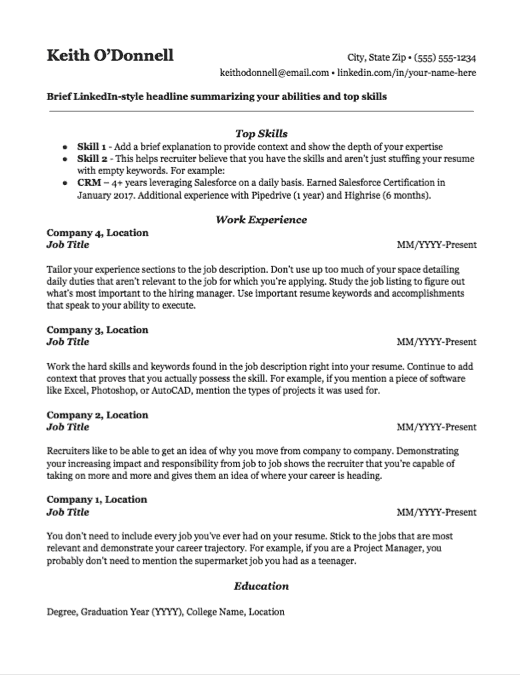
Classic Format Resume Templates

Chronological

These are the three standard resume formats : chronological, hybrid, and functional.
The chronological resume template offers a classic, no frills format. Consider this template if you work in a formal industry or want to bring attention to the impressive companies on your resume. Hybrid resume templates are versatile and the most popular format in today’s job search. Functional resume templates are popular for people changing careers or masking holes in their resume. Jobscan doesn’t typically recommend the functional resume format because recruiters may be suspicious of them .
Fill out your resume faster with our resume builder
Write your resume the free and easy way with the only resume builder designed specifically with ATS-compliant resume templates.
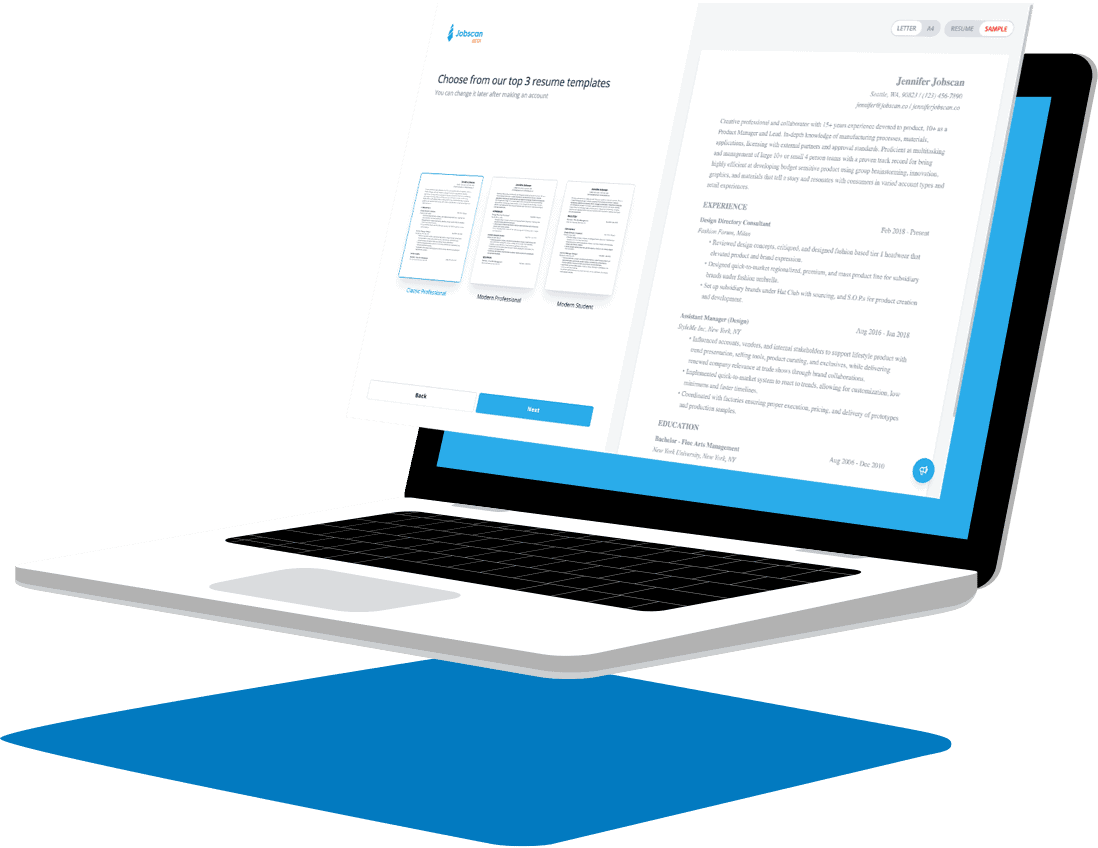
Senior Level and Executive Resume Templates
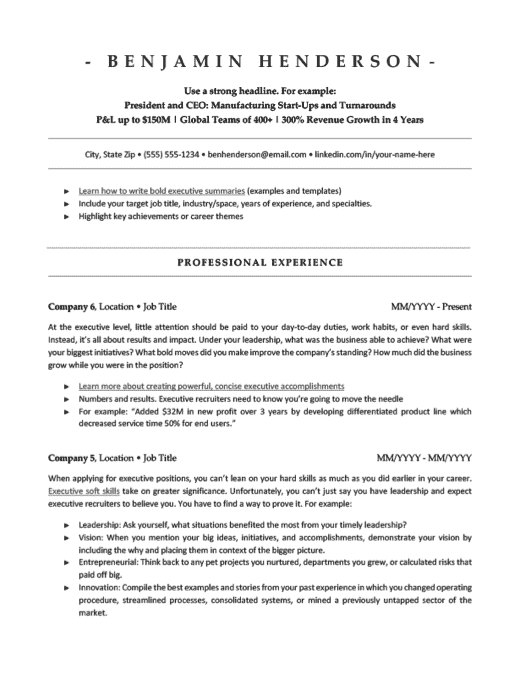
Once you begin applying to senior level positions, a greater emphasis is placed on the results your organizations have achieved and executive soft skills like leadership , innovation, and entrepreneurial drive. At the executive level, technical skills aren’t as important as they were earlier in your career. Fill out your executive resume template with accomplishments , measurable results, and examples of leadership .
Management Resume Templates
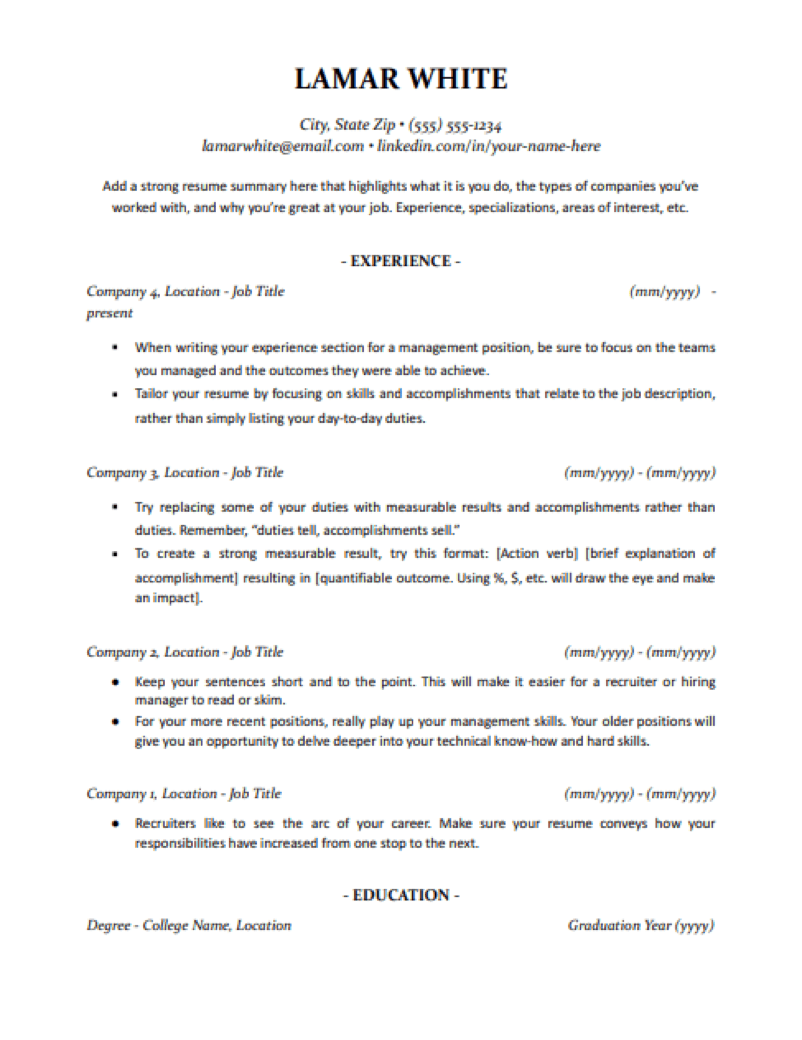
When it comes to writing a management-level resume, try to demonstrate a trajectory of growth along with a combination of deep industry knowledge and interpersonal skills. You need to prove that you’re an expert in your field who is able to delegate tasks and lead your team.
Mid-Career Resume Templates
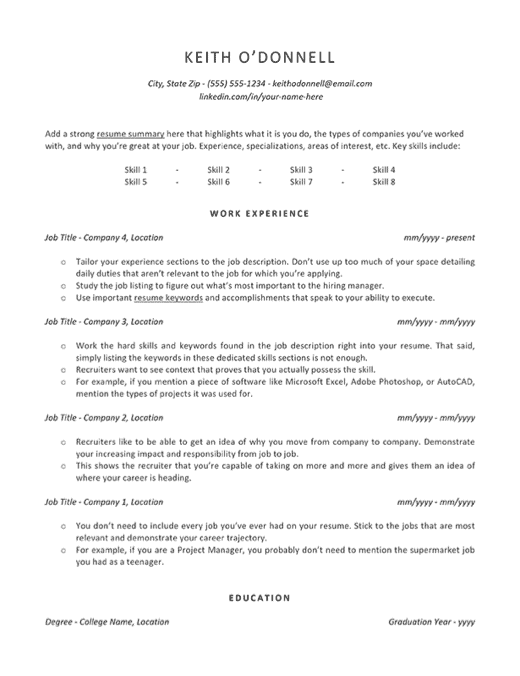
When you’re no longer entry-level but still working as an independent contributor (vs a manager), your resume needs to focus on your ability to execute. A strong emphasis should be on the hard skills found in the job description. Back these skills up with context to demonstrate your level of expertise.
Recent Grad Resume Templates
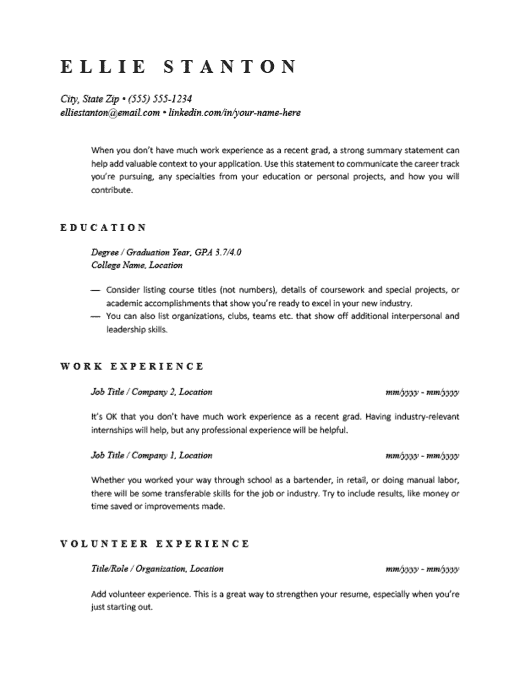
When you’re looking for an entry-level job right out of college, your resume is going to look a little different. Your education section is moved up above your work experience and you’re expected to expand upon your college experience. Go into detail with honors, clubs, coursework, etc.
The Importance of ATS-Friendly Resume Templates
If you’re uploading your resume into an online form as part of your job application, it is critical for your resume template to be compatible with applicant tracking systems (ATS) . An expertly written resume complete with a sleek design and optimized resume keywords and action verbs could still fall short if the formatting isn’t ATS compliant.
When you upload your resume , applicant tracking systems parse out the text to make it searchable for a recruiter. They may also transfer the information from our resume to a uniform digital candidate profile. Even if you’re perfectly qualified for the job, your chances of getting a job interview are much lower if an ATS can’t accurately parse your resume.
ATS-friendly resumes are often similar to minimalist resume templates but go a step further to account for ATS algorithms and behaviors. Among other considerations, ATS-friendly resume templates account for the fact that:
- Many ATS can’t handle tables or images.
- Parsing accuracy is dependent on heading names and correctly sequencing your work experience information.
- Certain resume fonts might not be displayed properly in all ATS.
- PDF and docx file types work better than others.
Find out if your resume is ATS-optimized with Jobscan’s resume optimization tool . It will help you write the perfect resume so that you stand out from the competition.
How to Use a Resume Template
Be Selective
Finding the right resume template for you is the first step. Select a template that is ATS-friendly and includes space for all the elements you need to tell your story.
Customize Your Template
Not finding the perfect resume template? Select the best one and make some adjustments. For example, you can remove a hobbies section if you need more room for your work history, add a space for key certifications that don’t fit in the template or add a skills section to better highlight your technical skills.
Resume templates are meant to be a guide to a better resume, not an unbreakable set of rules.
Tailor Your Resume to the Job Every Time
Recruiters and hiring managers are more likely to respond to a resume that is carefully tailored for the specific position .
This means using the job description to focus on the skills and keywords that are most important to the job. Showing that you are results-oriented is another great way to show you are the best candidate. Including relevant measurable results and accomplishments on your resume help demonstrate that you understand what is most important to the company’s success.
After you’ve tailored your resume information within the template, run it through Jobscan’s resume optimization tool to see how well it matches the job. In fact, more than 1 million job seekers have used our tool to help them find the next step in their career—see how it can help you!
Are you still tracking jobs in Excel or Google Sheets? Track and manage your job applications and interviews all in one place with Job Tracker . With the click of a button add a job to Job Tracker. From there you can organize your resumes and job descriptions, keep track of important interview dates and details, and manage multiple job opportunities in one place.
Resume Template FAQs
What is the best resume template for me?
The best resume template is the one that provides room for you to showcase your relevant skills and tell the complete story of your relevant work experience. If you are an entry-level or mid-career applicant, look for a template that highlights your hard skills. For executive-level applicants, a template that focuses on your executive summary and work experience will be best.
Which resume format is best?
Recruiters prefer chronological or hybrid formatted resumes. All of the templates above are great choices! We do not recommend using a functional template, which focuses primarily on skills and downplays work history.
Read more: Why Recruiters Hate the Functional Resume Format
What is the difference between a resume template and a resume builder?
A resume builder is a tool that prompts you to enter your information into input fields and formats a resume for you. Resume templates are typically editable Microsoft Word files that are already formatted. Prefer the ease of a builder? Jobscan’s resume builder is 100% free!
More Resume Resources
Google Docs Resume Templates
ATS Resume Templates
Simple Resume Templates
Resume Builder
Ready to put your resume to the test?
What jobscan customers are saying.


- Build my resume
- Build a better resume in minutes
- Resume examples
- 2,000+ examples that work in 2024
- Resume templates
- Free templates for all levels
- Cover letters
- Cover letter generator
- It's like magic, we promise
- Cover letter examples
- Free downloads in Word & Docs
Free Resume Templates [Download & Print]
Customize your resume like you’d customize your favorite coffee order. Step into the limelight with a professional, simple, and ATS-friendly resume template designed to capture and keep the attention of recruiters and hiring managers.

- Create free custom resume template
- Resume templates by experience level
- Resume templates by role
- Frequently asked questions (FAQ)
Create a Custom Resume Template for Free

Create free resume template
Management Resume Templates

A management resume is a great choice if you are more experienced in your career. Whether you have plenty of experience in people management or you’re trying to get your first managerial role, these professional resume templates will help you stand out.
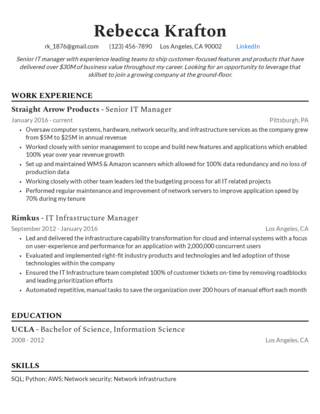
Senior-Level Resume Templates

When you start getting more experience under your belt, you need to have a resume that allows for you to showcase your career highlights. These senior level resume templates are designed to help you do exactly that.

Mid-Career Resume Templates

A mid-career resume should demonstrate an increase in the level of responsibility you’ve taken on throughout your career. These resume templates will help you draw focus to these responsibilities.

Entry-Level Resume Templates

As a new grad you need to convince the hiring manager you’re capable of performing the role you’re applying to without having past experience to draw on. These new grad resume templates will help you accomplish that.

Resume Templates by Role

Different career types have different resume requirements. A nurse applying to a large, old-school hospital is going to need a different resume template than a programmer applying to a tech company. These resume templates are meant to make that selection process easier for you.

A job resume is a short, sweet, and to-the-point document that spotlights your professional experience. It’s basically a summary.
Whether you’ve been in the workforce for 15+ years, have no job experience, or are somewhere in between, resumes have been sparking fear and dread in job seekers since approximately 1482 when Leonardo De Vinci drafted what became known as the first resume .
Resumes are what just about any place of employment requests when you apply for a job. Companies—big and small—wanna know:
◉ What skills do you bring to the job? ◉ Do you have relevant work experience for the role? ◉ Do you want to work for them?
A good resume answers those questions—and isn’t so unlike De Vinci’s resume that honed in on how he could meet the specific needs and challenges of the Duke of Milan.
Happy dance! Yes, our BeamJobs templates are absolutely free.
You can download our eight resume templates at no cost in Word and Google Docs formats. Edit BeamJobs-created resume templates for free in our builder. Only pay for premium features if you like what you see (hey, we gotta make a living, too!).
We also update our site from time to time with fresh Google Docs resume templates and Word resume templates , which will always remain free for you.
The best resume template is the one that complements your personality and allows the space you need to highlight your finest work, top achievements, and job skills.
Every resume template you see on this page has been thoroughly vetted by hiring experts to ensure they include everything you need to help you land your next job. Whether you’re applying to a funky tech startup or looking to join the ranks of a reputable law firm, you’ll find a professional resume template that speaks to you.
Hunting for a new job is incredibly stressful as there’s a lot of uncertainty in the process. And while these resume templates won’t alleviate all stress, they’ll ensure your resume has everything you need to sail through an applicant tracking system (ATS) and impress hiring managers.
Try saying “applicant tracking system” 10 times fast, and you’ll know why it got shortened to ATS.
At its core, an applicant tracking system puts the gas on hiring. Typically, when folks think about ATS software, they think about it weeding out resumes that don’t include the right skills or qualifications.
That’s certainly true enough, but the ATS also helps HR and recruiters organize and sort job candidates, keeps track of communication with job seekers, sets up interviews, and does a host of other not-so-fascinating things.
Basically, when you choose an ATS-friendly resume template from BeamJobs, you can rest easy knowing that the document itself will make it through the software
When it comes to your resume, it will house these staple sections:
◉ Contact info (Triple-check the spelling of your name; see the question about “how to make a resume” for a cringe-worthy BeamJobs blunder.) ◉ Work experience ◉ Skills ◉ Education
Depending on your occupation and years of experience, you could add these optional resume sections:
◉ Resume summary or resume objective ◉ Hobbies and interests ◉ Projects (an umbrella term for things like volunteer experience, academic or personal projects, etc.)
The more relevant job experience you have, the longer the “work experience” section of your resume should be since that’s what employers care about most. On the other hand, when you’ve recently graduated and don’t have much (or any) experience, things like education and projects can take up more real estate on your resume.
Whatever your professional background, our resume maker lets you re-arrange, remove, and add sections as needed to your resume template.
Not to blast our own horns, but we’ve reviewed tens of thousands of resumes in the last few years. Would you believe we’ve actually seen resumes without a name ?! Besides discovering disheartening news like that, we’ve figured out how to make a good resume .
There are plenty of resume tips we could give you, but here are three that, when followed, will most increase your chances of snagging an interview:
Use numbers to showcase your impact in past roles. Your work experience should focus on your measurable accomplishments, not on job responsibilities.
Tailor your resume for each job you apply to, which means reading each job description carefully. As you read, see if any prior work projects come to mind. Include those projects on your resume.
Avoid grammar and spelling errors. We know, you’ve heard it before. But you’d be aghast (fun word) at the number of folks rejected for a job because of this. (C ough cough We won’t say his real name, but one of our team members whose title rhymes with re-bounder once sent out 20 resumes with his name spelled ‘Stepen.’)
One page—plain and simple.
While you might get away with a two-page resume if you’ve got 10-plus years of experience under your hat, keep in mind that recruiters and hiring managers aren’t giving your resume the time of day it deserves anyway.
The most painful part of building a resume is editing yourself. How can your entire career fit into four or five bullet points for each job you’ve had? Here’s some good news: if you’re a senior engineer, it’s totally cool to drop from your resume the server job you had in college.
Even if you whittled the jobs you’d include down to three or four, try starting with a basic resume outline . Fill it to your heart’s content; then, review every job experience bullet point individually and ask, “Does this point show my expertise and say something new?” If the answer’s no, exclude it. Before you know it, you’ll have a polished one-page resume.

Search Results
No matching results, recently viewed.
Listening...
Sorry, I don't understand. Please try again

What’s the best resume format in 2024?
- X (Twitter)
- Copy link Link copied
The emergence of all-digital hiring processes. The increasing importance of ongoing learning and development. The extent to which work-from-home options have become a baseline expectation among candidates.
It’s obvious that the world of work is changing rapidly, but not everyone realizes how resume-writing best practices are changing with it.
What’s new? What isn’t? And what do you need to know in order to present your candidacy in the best way possible? In this article, we’ll delve into three of the highest-impact resume formats for 2024:
- Reverse-chronological resumes
- Functional resumes
- Combined resumes
In addition to guidance, recommendations and use cases, we’ve included downloadable templates for each resume format below—so go ahead and bookmark this page as your definitive resume playbook going forward. Plus, once you’ve got your own resume together, you should check out all of the job opportunities available at Johnson & Johnson .
- Presents an easy-to-follow, linear career narrative, beginning with your most recent professional experience and working backward from there
- The most widely used resume format
- Eliminates confusion and presents your professional experience in a clear, easy-to-understand format
- Usually creates an impression of career growth and progression
- May call attention to gaps in your employment history
- Skills and competencies aren’t always clear
- Not the best format if you’re pursuing a new path in your career

Note that the numbers in the list below correspond to the numbers in the image above—and that you can download our reverse-chronological resume template if you want to start customizing your own.
- Start with your name and contact information (which should be pretty straightforward), type in the role you’re applying for and move on to the candidate statement—the part where you try to connect your experience, interests and areas of expertise to the role in question. Do you best to keep it succinct, aiming to hit all the key points in three sentences or less.
- Next, summarize—two or three sentences, max—your day-to-day responsibilities in the role, keeping the details at a fairly high level and saving specific accomplishments for the bullet points. Try to make the tone and voice consistent with your candidate statement.
- Finally, time to wrap it all up. This section is where you can provide a quick summary of relevant details related to education, certification, training and professional development.
- Functional resumes zero-in on specific projects, experiences and outcomes, thereby placing the emphasis on your skills and competencies, rather than your overall career progression
- Great option for candidates who work in project-based, freelance or consultative capacities
- Shows how you contribute value by connecting skills to outcomes
- Doesn’t chronologically document your career trajectory—the overall timeline isn’t going to be immediately clear, for example
- May leave unanswered questions in the minds of some recruiters and hiring managers
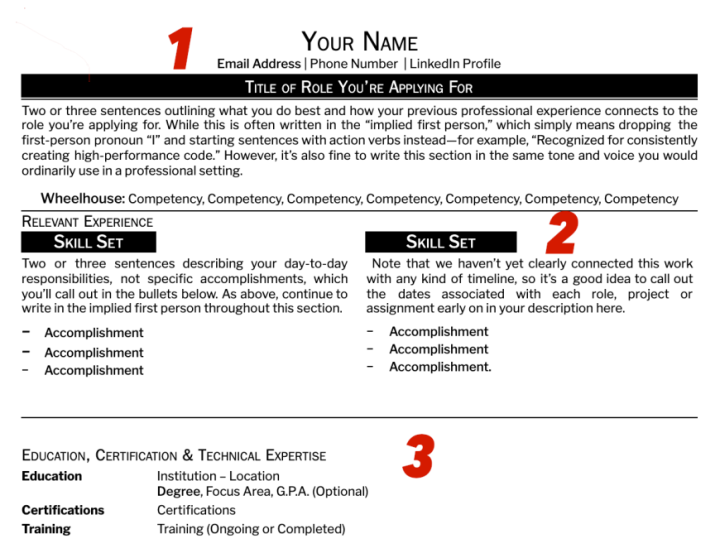
The numbers in the list below correspond to the numbers in the image above, and you can download our functional resume template if this seems like the right format for you—and you’re ready to start customizing your own.
- As in the first example on this page, jotting down your name and contact information is the first piece of the puzzle. Next, write the name of the job you’re applying for, followed by a short candidate statement, which answers the vital “why” questions: Namely, why should you be called up for an interview? Why are you the right candidate for this job?
- This is where you can break down your most directly relevant work experience for the job at hand. Emphasize dollars-and-cents value, or quantitative benefits you’ve delivered in the past, as much as possible. You want your skills to stand out.
- Close with relevant information about certifications, education or training you have received. Keep it short and sweet.
- Combined resumes bring together the narrowly focused, more curated approach of a functional resume with the holistic perspective of a reverse-chronological resume
- Highlights key areas where you can make an impact without skipping over the broader story of your overall work experience
- Can be more concise than a reverse-chronological resume
- Usually less concise than a strictly functional resume
- May not be immediately clear to hiring managers and recruiters what type of resume they’re dealing with, thereby creating confusion

The numbers in the list below correspond to the numbers in the image above. Be sure to download our combined resume template if you’re ready to start customizing your own.
- Note that this one looks a lot like a functional resume, but with one notable addition (see number three). As before, start with your name, the job you’re applying for and your candidate statement.
- Call out projects, skills and experiences that are relevant to the job you’re applying for, doing your best to quantify deliverables—for example, the budget, timeline for completion or number of stakeholders involved—wherever possible.
- Document your work history, adhering to the organizational principles of a reverse-chronological resume—that is, starting with your most recent work experience and working backward in time from there. Be sure to include dates. Keep this as succinct as possible.
- Finally, be sure to include information around certifications, education or training that you have received.

IMAGES
VIDEO
COMMENTS
Best resume format example. The chronological resume format is what most job seekers should be using when applying for jobs: Download a Chronological Resume. When to use this format: You have no obvious gaps in your employment and want to emphasize your career progression. The chronological resume format is the most common type of resume.
10. Send your resume as a PDF. Sending a PDF resume file, unless stated otherwise in the job description, will allow your document to remain intact, keeping the same structure and length. Plus, PDF format is operable on most devices, so your recruiter can surely access it.
3 main types of resume formats. Luckily when it comes to choosing a resume format, your choices are already narrowed down to three main types: Reverse chronological. Functional. Combination. Each one offers unique advantages and there are no best resume templates.
Here's what to include in a functional resume format: 1. Contact information. Include the basics here: first and last name, phone number, location, email address, LinkedIn URL. You can also add (although it's optional) the following: portfolio, blog, social media with content relevant to the position….
The "Millennial" resume template features a modern look and extra space for a personal photo. If you're a social media influencer, video editor, or in any way involved with creating content, then this resume is perfect for you. Pick this template if you're making a: College student resume. Server resume. Bartender resume.
Combination resume format. 3. The chronological resume format. Present your work experience in time order, but in reverse, to best use the chronological resume format. That's because your most recent experience is the most important for employers to consider. Use this format unless there is a reason to use one of the other two.
Tip #2: Choose a Professional and Legible Font. When a hiring manager at your potential new job reads your resume summary, you want the words to flow well. That starts with selecting a professional and easy-to-read font. This can also be helpful if the resume goes through an applicant tracking system.
What to keep in mind about 2022 job trends. Remote and hybrid work environments are an important 2022 job trend to keep in mind for recruiters and job seekers alike. This is because companies are able to hire from a more diverse applicant pool. Physical location no longer plays such a crucial role in the hiring process.
Modern resumes rely on striking colors such as blue, green, and purple to highlight important pieces. This keeps the recruiter organized and attentive while reading. White Space. The resume body is evenly balanced by the white space. Since modern resume templates employ bold design elements, standard margins and clean space keep the sections ...
Good for professionals in the business world or IT industries. Square brackets, bullet lists, infographics, and icons work together in this template to attract the hiring manager's attention and get them to go over your work experience and achievements in depth. #5. Creative Resume Template. Pick Template.
This modern resume template uses black-and-white contrast to make your name stand out. The eye-catching black header screams confidence, while the white background adds harmony to the template. You can choose progress bars for software skills to ensure recruiters read your resume from top to bottom. 9. Cubic by Zety.
Pro tip: Left-align all the text on your resume since it's the easiest format for reviewers to read. If you prefer, you can center-align your name, contact information and headline. If you do choose to center-align any text, this is the only section that should be considered. 2. Select a professional, readable font.
See resume templates and examples for the perfect resume. close. Builders. Resume. Create a professional-level resume with ease. 30+ dazzling design options! CV. Make a CV for free with 30+ professional designs and guided automation! Cover Letter. ... New graduates: Often benefit from a functional or combination resume, ...
6. Feature your name and job title in the header. You're the star of your resume, so don't be shy when you format your name on your resume header. Write your name in extra-large, bold text, and then list your contact information in the same font size you use for the rest of your resume. 7. Add a bit of color.
It's wrong. At least, for experienced candidates: 95% of resume writers think a single-page resume is best for people with less than a year of work experience. 82% advocate for a one-pager for candidates with 1-5 years of experience. 49% say a one-pager is a good idea for those with 5-10 years in the workforce.
Jobscan's free Microsoft Word compatible resume templates feature sleek, minimalist designs and are formatted for the applicant tracking systems that virtually all major companies use. Build Resume Now Boost Existing Resume. Downlowow. Downlowow. Downlowow. Classic Format Resume Templates. Senior Level and Executive Resume Templates.
Whatever your role or experience, our resume templates are built to get your foot in the door. Resumes. AI resume builder Build a better resume in minutes Resume examples 2,000+ examples that work in 2024 ... As a new grad you need to convince the hiring manager you're capable of performing the role you're applying to without having past ...
Learn what's new in 2024—and what isn't—in order to present your candidacy in the best-possible light. The world of work is rapidly changing, and resume-writing practices are changing with it. ... recommendations and use cases, we've included downloadable templates for each resume format below—so go ahead and bookmark this page as ...
Sample resumes for every industry and job & writing tips + copy-paste templates. Download for free. Over 430 HR-approved resume examples. Sample resumes for every industry and job & writing tips + copy-paste templates. ... We're always adding new resume examples to our library, so if you don't see the one you need now we might have it in ...